Yamaha EL-100 Owner's Manual
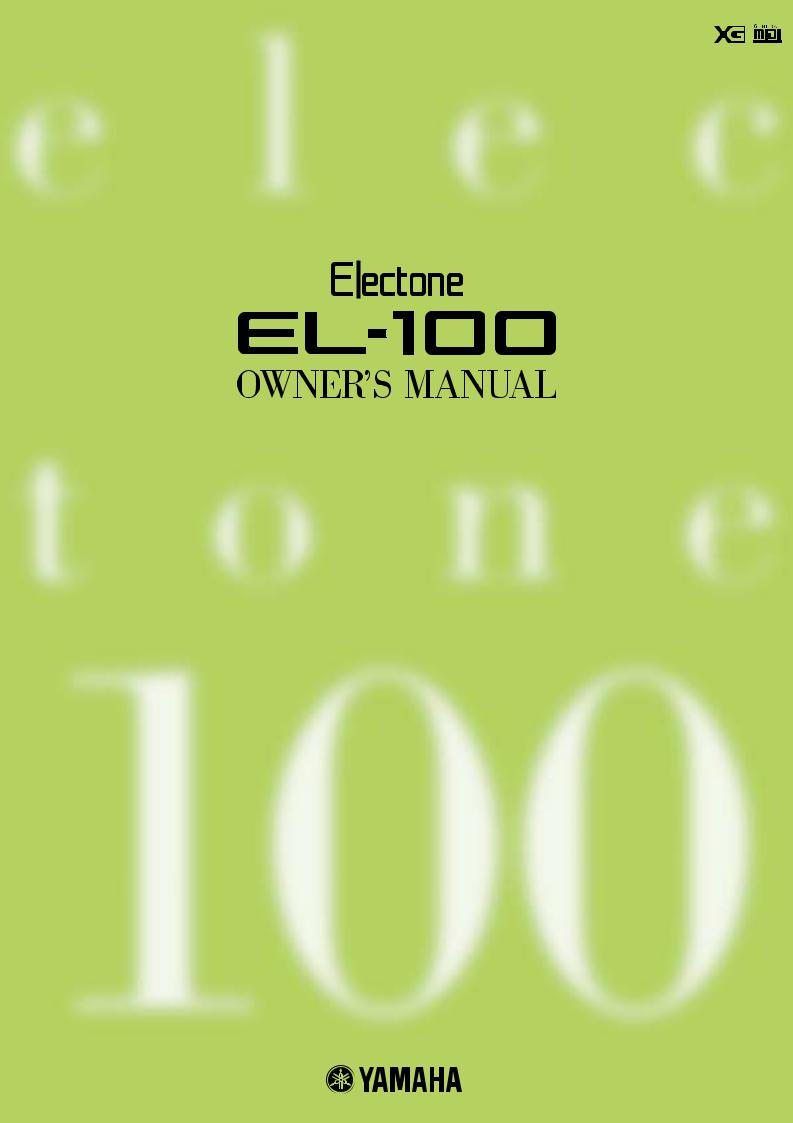
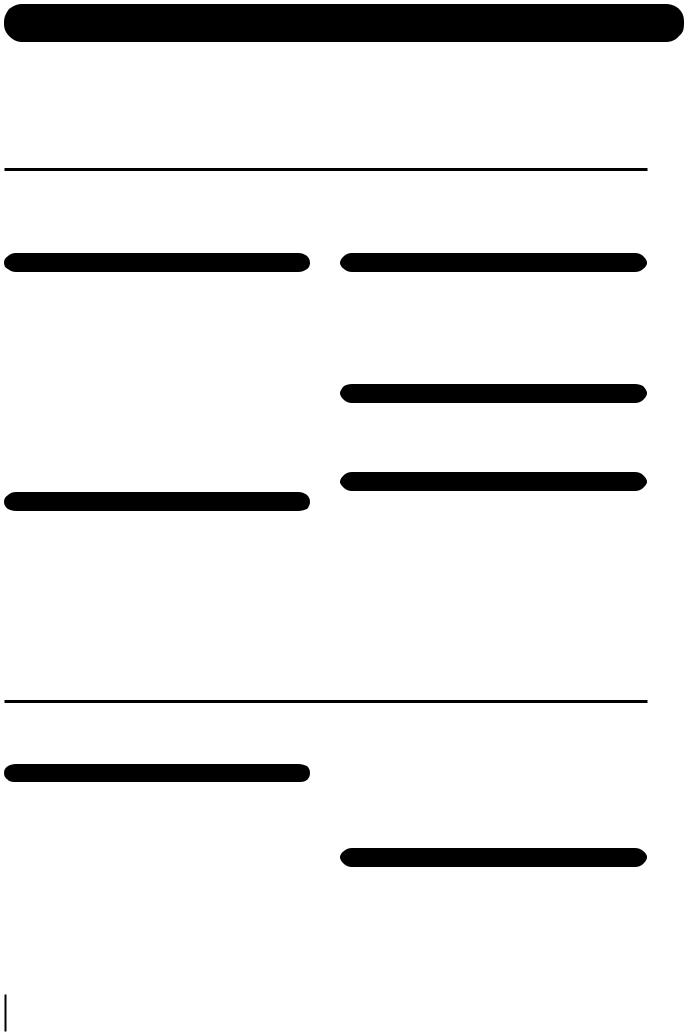
PRECAUTIONS
PLEASE READ CAREFULLY BEFORE PROCEEDING
* Please keep this manual in a safe place for future reference.
 WARNING
WARNING
Always follow the basic precautions listed below to avoid the possibility of serious injury or even death from electrical shock, short-circuiting, damages, fire or other hazards. These precautions include, but are not limited to, the following:
Power supply/Power cord
•Only use the voltage specified as correct for the instrument. The required voltage is printed on the name plate of the instrument.
•Check the electric plug periodically and remove any dirt or dust which may have accumulated on it.
•Use only the supplied power cord/plug.
•Do not place the power cord near heat sources such as heaters or radiators, and do not excessively bend or otherwise damage the cord, place heavy objects on it, or place it in a position where anyone could walk on, trip over, or roll anything over it.
Do not open
•Do not open the instrument or attempt to disassemble the internal parts or modify them in any way. The instrument contains no user-serviceable parts. If it should appear to be malfunctioning, discontinue use immediately and have it inspected by qualified Yamaha service personnel.
Water warning
•Do not expose the instrument to rain, use it near water or in damp or wet conditions, or place containers on it containing liquids which might spill into any openings.
•Never insert or remove an electric plug with wet hands.
Fire warning
•Do not put burning items, such as candles, on the unit. A burning item may fall over and cause a fire.
If you notice any abnormality
•If the power cord or plug becomes frayed or damaged, or if there is a sudden loss of sound during use of the instrument, or if any unusual smells or smoke should appear to be caused by it, immediately turn off the power switch, disconnect the electric plug from the outlet, and have the instrument inspected by qualified Yamaha service personnel.
 CAUTION
CAUTION
Always follow the basic precautions listed below to avoid the possibility of physical injury to you or others, or damage to the instrument or other property. These precautions include, but are not limited to, the following:
Power supply/Power cord
•When removing the electric plug from the instrument or an outlet, always hold the plug itself and not the cord. Pulling by the cord can damage it.
•Remove the electric plug from the outlet when the instrument is not to be used for extended periods of time, or during electrical storms.
•Do not connect the instrument to an electrical outlet using a multiple-connector. Doing so can result in lower sound quality, or possibly cause overheating in the outlet.
Assembly
•Read carefully the attached documentation explaining the assembly process. Failure to assemble the instrument in the proper sequence might result in damage to the instrument or even injury.
(1)B-7 1/2
2
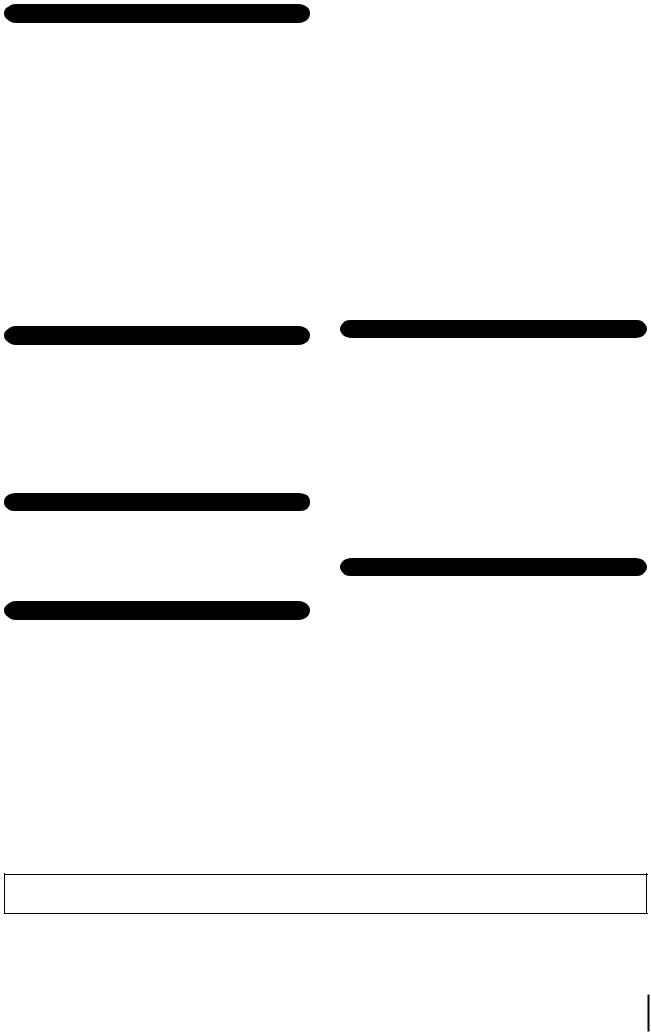
Location
•Do not expose the instrument to excessive dust or vibrations, or extreme cold or heat (such as in direct sunlight, near a heater, or in a car during the day) to prevent the possibility of panel disfiguration or damage to the internal components.
•Do not use the instrument in the vicinity of a TV, radio, stereo equipment, mobile phone, or other electric devices. Otherwise, the instrument, TV, or radio may generate noise.
•Do not place the instrument in an unstable position where it might accidentally fall over.
•Before moving the instrument, remove all connected cables.
•Do not place the instrument against a wall (allow at least 3 cm/ one-inch from the wall), since this can cause inadequate air circulation, and possibly result in the instrument overheating.
Connections
•Before connecting the instrument to other electronic components, turn off the power for all components. Before turning the power on or off for all components, set all volume levels to minimum. Also, be sure to set the volumes of all components at their minimum levels and gradually raise the volume controls while playing the instrument to set the desired listening level.
Maintenance
•When cleaning the instrument, use a soft, dry cloth. Do not use paint thinners, solvents, cleaning fluids, or chemical-impregnated wiping cloths.
Handling caution
•Do not insert a finger or hand in any gaps on the instrument.
•Never insert or drop paper, metallic, or other objects into the gaps on the panel or keyboard. If this happens, turn off the power immediately and unplug the power cord from the AC outlet. Then have the instrument inspected by qualified Yamaha service personnel.
•Do not place vinyl, plastic or rubber objects on the instrument, since this might discolor the panel or keyboard.
•Do not rest your weight on, or place heavy objects on the instrument, and do not use excessive force on the buttons, switches or connectors.
•Do not operate the instrument for a long period of time at a high or uncomfortable volume level, since this can cause permanent hearing loss. If you experience any hearing loss or ringing in the ears, consult a physician.
Using the bench (If included)
•Do not place the bench in an unstable position where it might accidentally fall over.
•Do not play carelessly with or stand on the bench. Using it as a tool or step-ladder or for any other purpose might result in accident or injury.
•Only one person should sit on the bench at a time, in order to prevent the possibility of accident or injury.
•If the bench screws become loose due to extensive long-term use, tighten them periodically using the included tool.
Saving data
Saving and backing up your data
•All panel settings and Registration Memories are lost when you turn off the power to the instrument. If you want to keep the settings, save the data to a floppy disk (see page 67).
Backing up the floppy disk
•To protect against data loss through media damage, we recommend that you save your important data onto two floppy disks.
Yamaha cannot be held responsible for damage caused by improper use or modifications to the instrument, or data that is lost or destroyed.
Always turn the power off when the instrument is not in use.
(1)B-7 2/2
3
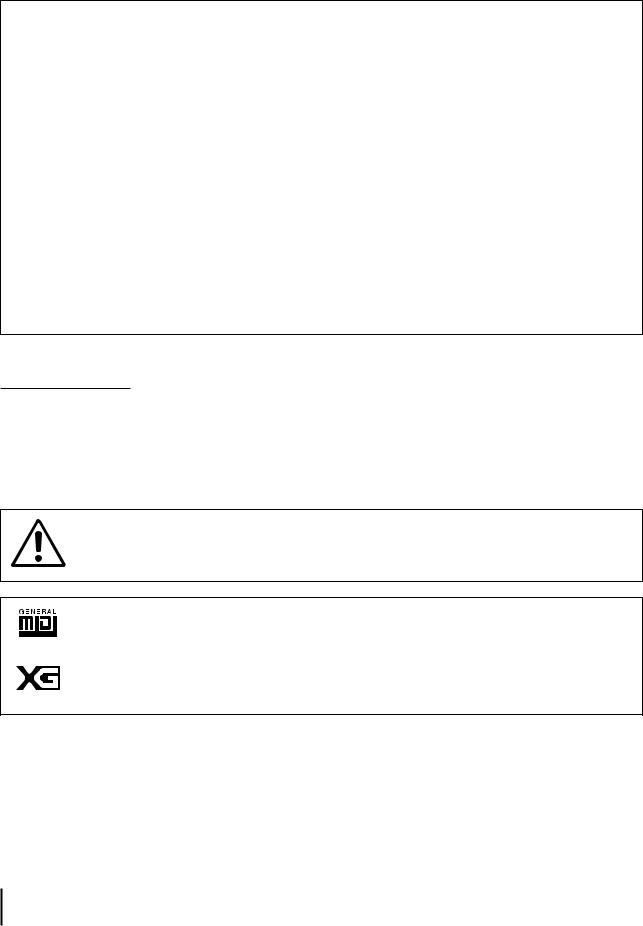
Congratulations!
You are the proud owner of a fine electronic organ, Electone EL-100.
The Yamaha EL-100 Electone combines the most advanced AWM tone generation technology with state-of-the-art digital electronics and features to give you stunning sound quality with maximum musical enjoyment.
In order to make the most of the Electone and extensive performance potential, we urge you to read the manual thoroughly while trying out the various features described.
Keep the manual in a safe place for later reference.
Included Items
Owner’s Manual
Music Stand
Dust Cover
Bench
Turning the Electone off erases all panel settings you have made. When the Electone is turned on, Basic
Registration 1 is automatically selected.
GM (General MIDI System Level 1) is an addition to the MIDI standard that ensures that any GM-compatible music data can be accurately played by any GM-compatible tone generator, regardless of maker.
The GM mark is affixed to all software and hardware products that support the General MIDI standard.
XG is a new MIDI format created by Yamaha that significantly improves and expands upon the General MIDI standard by providing a greater variety of high-quality voices plus considerably enhanced effect operation – while being fully compatible with GM.
•The screen displays and illustrations as shown in this owner’s manual are for instructional purposes only, and may appear somewhat different from those on your instrument.
•Copying of the commercially available music sequence data is strictly prohibited except for your personal use.
•The company names and product names in this Owner’s manual are the trademarks or registered trademarks of their respective companies.
•This product incorporates and bundles computer programs and contents in which Yamaha owns copyrights or with respect to which it has license to use others’ copyrights. Such copyrighted materials include, without limitation, all computer software, styles files, MIDI files, WAVE data and sound recordings. Any unauthorized use of such programs and contents outside of personal use is not permitted under relevant laws. Any violation of copyright has legal consequences. DON’T MAKE, DISTRIBUTE OR USE ILLEGAL COPIES.
4
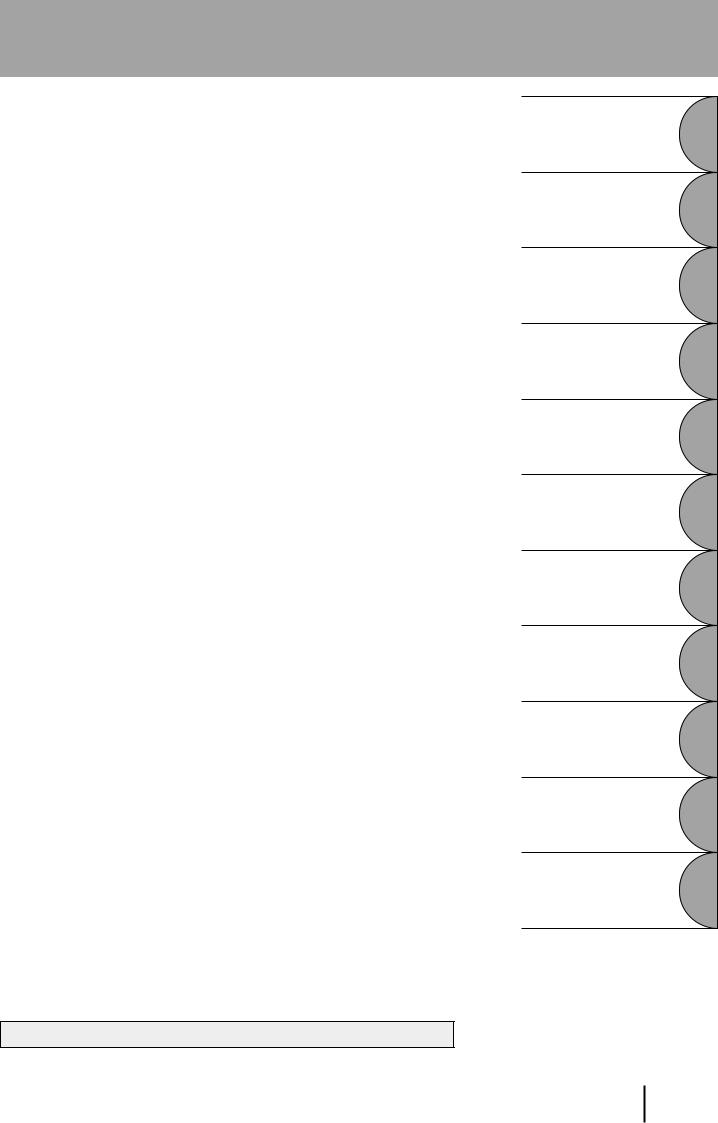
 Table of Contents
Table of Contents
Main Features ............................... |
6 |
||
Panel Layout ................................. |
7 |
||
EL-100 Panel Layout .......................................................... |
8 |
||
1 |
Quick Introductory Guide ........ |
10 |
|
|
1 |
Getting Started ................................................... |
10 |
|
2 |
Basic Registrations ............................................. |
11 |
|
3 |
Basic Operation .................................................. |
12 |
|
4 |
LCD DISPLAY ................................................... |
13 |
2 |
Voice Sections ......................... |
17 |
|
|
1 |
Voice Display ....................................................... |
17 |
|
2 |
Selecting Voices from the Panel ........................ |
18 |
|
3 |
Selecting Voices from the Dotted Buttons ....... |
21 |
|
4 |
Voice Menus ........................................................ |
23 |
3 |
Voice Controls and Effects ....... |
29 |
|
|
1 |
Selecting from Voice Condition Pages ............. |
30 |
|
|
(PAGE 1) .............................................................. |
30 |
|
|
1 Initial Touch .................................................... |
30 |
|
|
2 Feet .................................................................. |
30 |
|
|
(PAGE 2) .............................................................. |
31 |
|
|
1Volume ............................................................. |
31 |
|
|
2 Panning ............................................................ |
31 |
|
|
3 Reverb .............................................................. |
31 |
|
|
(PAGE 3) .............................................................. |
32 |
|
|
1 Effect ............................................................... |
32 |
|
|
(PAGE 4) .............................................................. |
33 |
|
|
1Vibrato ............................................................. |
33 |
|
|
(PAGE 5) .............................................................. |
34 |
|
|
1 Tune ................................................................. |
34 |
|
|
2 Slide ................................................................. |
34 |
|
2 |
Selecting from Effect Set Page ......................... |
34 |
|
|
1 Tremolo/Chorus .............................................. |
35 |
|
|
2 Symphonic/Celeste ......................................... |
35 |
|
|
3 Delay ................................................................ |
36 |
|
|
4 Flanger ............................................................. |
38 |
|
|
5 Distortion ......................................................... |
39 |
|
3 |
Selecting from the Panel .................................... |
40 |
|
|
1 Reverb .............................................................. |
40 |
|
|
2 Sustain ............................................................. |
41 |
|
|
3 Tremolo/Chorus .............................................. |
42 |
4 Rhythm and Accompaniment .. |
45 |
||
|
1 |
Selecting Rhythms from the Panel ................... |
45 |
|
2 |
Rhythm Condition Pages .................................. |
48 |
|
3 |
Dotted Buttons and User Rhythms .................. |
49 |
|
4 |
Rhythm Menus ................................................... |
51 |
|
5 |
Automatic Accompaniment - |
|
|
|
Auto Bass Chord (A.B.C.) ................................ |
52 |
|
6 |
Accompaniment Controls ................................. |
54 |
|
7 |
Preset/User Keyboard Percussion .................... |
56 |
|
8 |
Melody On Chord (M.O.C.) ............................. |
64 |
5 Registration Memory .............. |
67 |
|
1 |
Storing Registrations ......................................... |
67 |
2 |
Selecting Registrations ...................................... |
68 |
3 |
Saving the Registration Data to Disk .............. |
68 |
4 |
Registration Shift ............................................... |
69 |
6 Music Disk Recorder (M.D.R.) .. |
73 |
|
1 |
Precautions on M.D.R. ...................................... |
73 |
2 |
Formatting a Disk .............................................. |
75 |
3 |
Recording ............................................................ |
76 |
4 |
Recording Registrations (and Bulk Data) ...... |
82 |
5 |
Recalling Recorded Registrations |
|
|
(and Bulk Data) .................................................. |
83 |
6 |
Replacing Registrations .................................... |
83 |
7 |
Playback .............................................................. |
84 |
8 |
Other Functions .................................................. |
88 |
7 |
Footswitches and |
|
|
|
Expression Pedal .................... |
97 |
|
|
1 |
Footswitch ........................................................... |
97 |
|
2 |
Expression Pedal .............................................. |
100 |
8 |
Transpose and Pitch Controls |
101 |
|
9 |
MIDI ...................................... |
102 |
|
10 Accessory Jacks and Controls .... |
104 |
||
11 Appendix ............................. |
105 |
||
|
MIDI .......................................................................... |
105 |
|
|
MIDI Data Format .................................................. |
111 |
|
|
MIDI Implementation Chart ................................. |
120 |
|
|
Troubleshooting ....................................................... |
122 |
|
|
EL-100 ASSEMBLY INSTRUCTIONS ................ |
125 |
|
|
EL-100 Specifications .............................................. |
129 |
|
|
Index .......................................................................... |
131 |
|
The Index on page 131 can be of your help in finding the functions and terms.
1 Quick Introductory
Guide
2 Voice Sections
3 Voice Controls
and Effects
4 Rhythm and
Accompaniment
5 Registration Memory
6 |
Music Disk Recorder |
(M.D.R.) |
7 Footswitches and
Expression Pedal
8 Transpose and
Pitch Controls
9 MIDI
10 Accessory Jacks
and Controls
11 Appendix
5

 Main Features
Main Features
1 Astoundingly True-to-life Sounds
The new AWM (Advanced Wave Memory) tone generation technologies combined with authentic touch response make this Electone a truly expressive musical instrument.
You can enjoy playing a total of 173 AWM voices using the touch response function.
2 Wide Variety of High Quality Effects
Electone voices can also be enhanced with a full range of high-quality digital effects, ranging from Tremolo and Reverb to Flanger, Delay and Distortion. Stereo panning is independent of effect on/off status. (page 34)
3 Dynamic Rhythm Patterns and Programmable Percussion Sounds
The Rhythm section of the Electone features authentic drum and percussion sounds, used by expert rhythm programmers in creating a total of 66 rhythm patterns, ranging across all styles of music. (page 45)
The Keyboard Percussion function lets you play 120 different percussion sounds, each of which can be assigned onto any key. (page 56)
4 Convenient Registration Functions
The Basic Registrations let you instantly change the voices for playing any styles of music. (page 11)
Also, Registration Memory Function lets you set up and record your own Electone settings, and call up them in the middle of the performance. (page 67)
5 Versatile Functions of the Music Disk Recorder
The Electone also features a Music Disk Recorder (MDR) for recording your registrations and performances to a floppy disk. In addition, the MDR allows you to copy a song from a disk to another, duplicate a disk, and play commercially available XG song data. (page 73)
6 LCD for Systematic and Intuitive Operation
The systematic and intuitive LCD allows you to smoothly understand almost all the Electone operation.
6
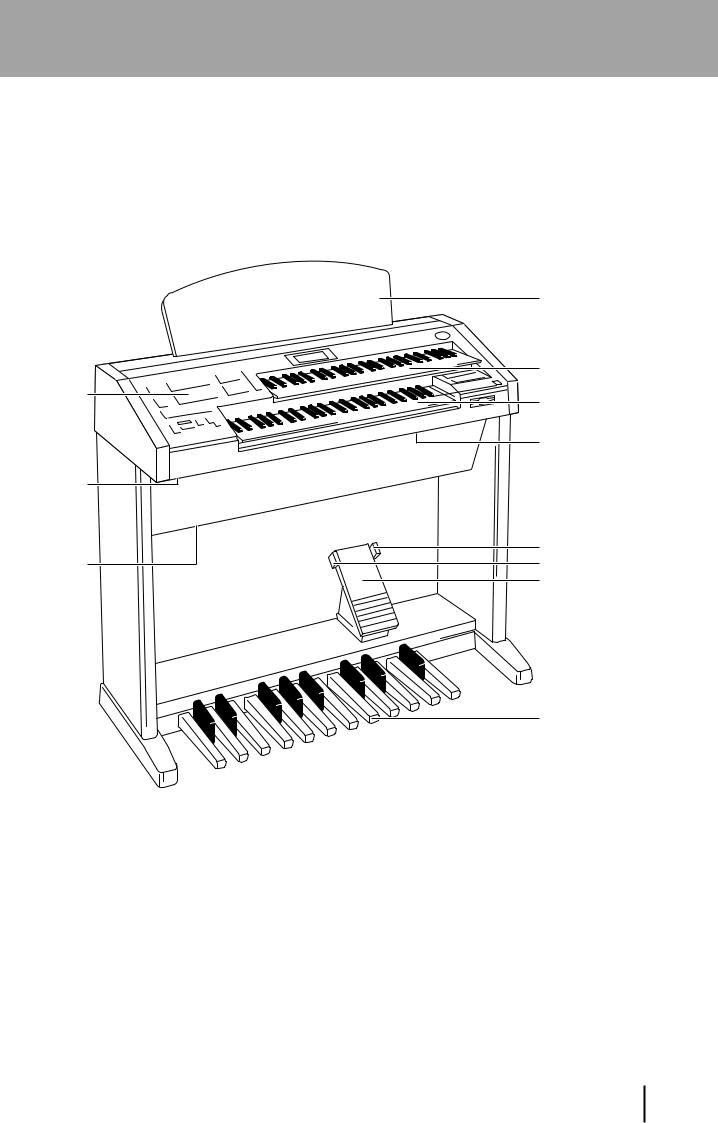
 Panel Layout
Panel Layout
Front Panel (pages 8-9)
Jacks (page 104)
Speaker Unit
Music Stand
Upper Keyboard
Lower Keyboard
MIDI Jacks (page 104)
Right-Footswitch (page 69)
Left-Footswitch (page 97)
Expression Pedal (page 11)
Pedalboard
7
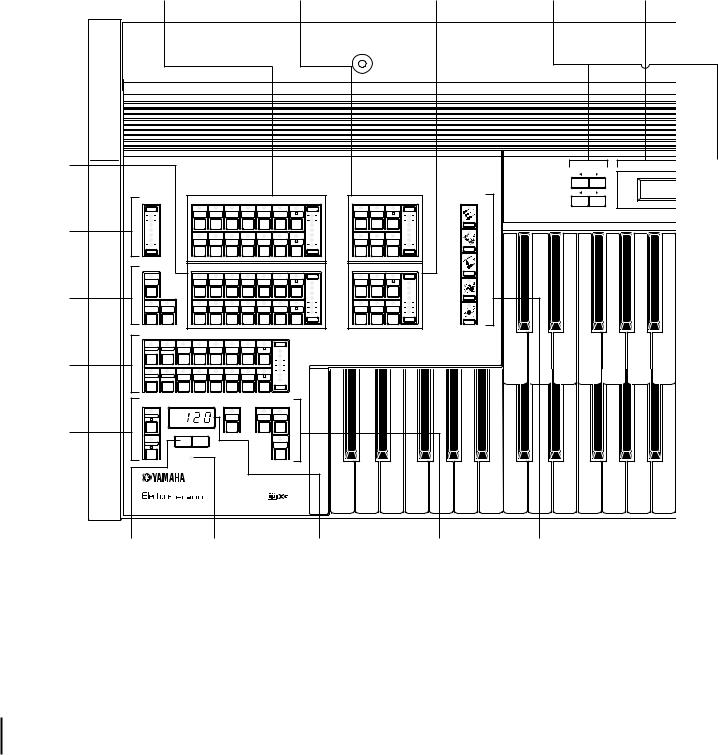
EL-100 Panel Layout
UPPER KEYBOARD VOICE |
LEAD VOICE |
PEDAL VOICE |
DATA CONTROL |
LCD Display |
(page 17) |
(page 17) |
(page 17) |
(page 14) |
(page 13) |
LOWER KEYBOARD VOICE (page 17)
REVERB (page 40)
SUSTAIN (page 41)
|
|
|
|
|
|
|
|
|
|
|
|
DATA CONTROL |
|
|
|
|
|
|
|
|
|
|
|
|
¨⁄String |
|
|
|
|
|
|
|
|
|
|
|
|
Ò⁄String |
REVERB |
|
|
|
|
|
|
|
|
|
|
|
BASIC |
|
|
|
UPPER KEYBOARD VOICE |
|
|
LEAD VOICE |
REGIST. |
|||||
MAX |
|
STRINGS |
BRASS |
CLARI- |
SAXO- |
CHORUS |
HARMO- |
MAX |
VIOLIN |
FLUTE |
|
MAX |
|
|
|
|
NET |
PHONE |
|
NICA |
|
|
|
|
|
|
|
ORGAN |
PIANO |
GUITAR |
VIBRA- |
COSMIC |
TUTTI |
|
OBOE |
TRUM- |
TO |
|
|
|
|
|
|
PHONE |
|
|
|
|
PET |
LOWER |
|
MIN |
|
|
|
|
|
|
|
MIN |
|
|
|
MIN |
SUSTAIN |
|
|
LOWER KEYBOARD VOICE |
|
|
PEDAL VOICE |
|
|||||
UPPER |
|
STRINGS |
BRASS |
CLARI- |
SAXO- |
CHORUS |
HORN |
MAX |
CONTRA |
ELEC. |
|
MAX |
|
|
|
|
NET |
PHONE |
|
|
|
BASS |
BASS |
|
|
LOWER |
PEDAL |
ORGAN |
PIANO |
GUITAR |
VIBRA- |
COSMIC |
TUTTI |
|
ORGAN |
TUBA |
TO |
|
|
|
|
|
|
PHONE |
|
|
|
BASS |
|
LOWER |
|
|
|
|
|
|
|
|
|
MIN |
|
|
|
MIN |
RHYTHM (page 45)
KEYBOARD PERCUSSION (page 56)
RHYTHM
SEQ. |
SEQ. |
MARCH |
WALTZ |
SWING |
BOUNCE |
SLOW |
MAX |
1 |
2 |
|
|
|
|
ROCK |
|
SEQ. |
SEQ. |
TANGO |
LATIN |
LATIN |
8 BEAT |
16 BEAT |
|
3 |
4 |
|
1 |
2 |
|
|
|
|
|
|
|
|
|
|
MIN |
KEYBOARD |
|
BAR / BEAT |
|
|
RHYTHM |
|
|
PERCUSSION |
|
|
|
||||
LOWER |
|
|
|
|
INTRO. |
SYNCHRO |
START |
|
|
|
|
|
ENDING |
START |
|
|
|
TEMPO |
|
|
|
|
|
PEDAL |
|
|
|
|
|
|
FILL IN |
|
|
BAR / BEAT |
|
|
|
|
|
TEMPO |
BAR/BEAT |
BAR/BEAT/TEMPO |
RHYTHM |
BASIC REGIST. |
(page 47) |
(page 47) |
(page 47) |
(page 46) |
(page 11) |
8
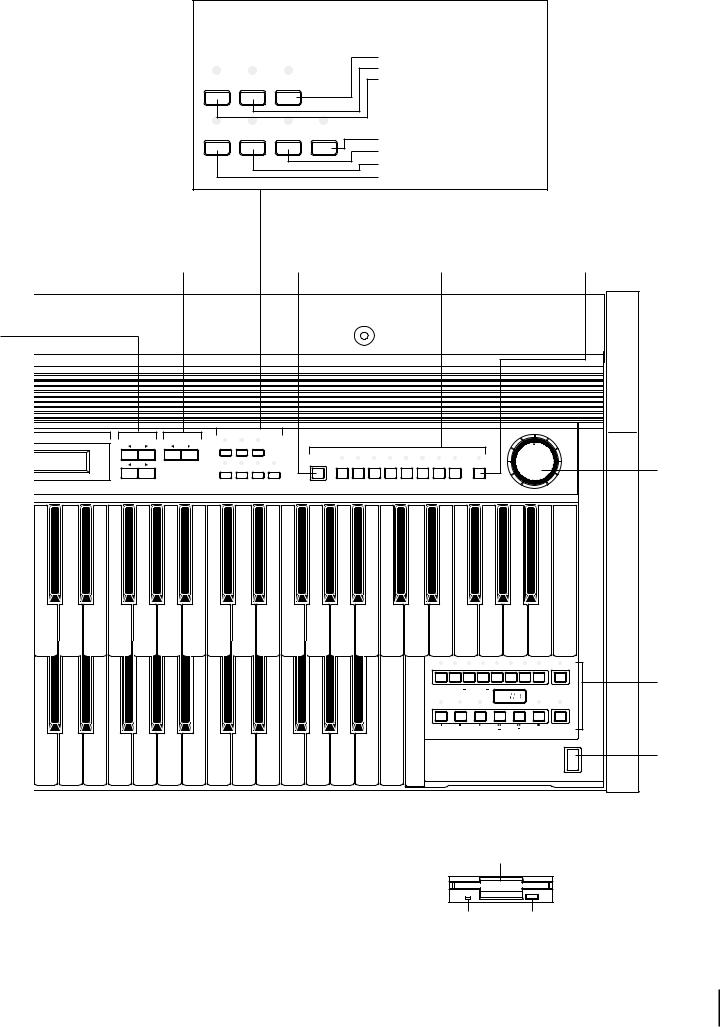
DISPLAY SELECT (page 15) |
|
|||
|
DISPLAY SELECT |
|
A.B.C./M.O.C. Button (pages 52, 64) |
|
|
|
|
|
EFFECT SET Button (page 34) |
VOICE |
EFFECT |
A.B.C. |
|
VOICE DISPLAY Button (page 20) |
DISPLAY |
SET |
M.O.C. |
|
|
FOOT |
REGIST. |
PITCH TREMOLO |
|
|
SW. |
SHIFT |
MIDI |
(FAST) |
TREMOLO (FAST) Button (page 44) |
|
|
|
|
|
|
|
|
|
PITCH/MIDI Button (pages 101, 102) |
|
|
|
|
REGIST. SHIFT Button (page 69) |
|
|
|
|
FOOT SW. Button (page 97) |
PAGE |
M./TO DISK |
Registration Memory |
D. (Disable) |
(page 14) |
(page 67) |
(page 67) |
(page 68) |
|
|
|
DISPLAY SELECT |
|
|
|
|
|
|
|
|
|
MASTER VOLUME |
||
|
|
|
|
|
|
|
|
|
|
|
|
|
|||
DATA CONTROL |
PAGE |
VOICE |
EFFECT |
A.B.C. |
|
|
|
|
|
|
|
|
|
|
|
|
|
DISPLAY |
SET |
M.O.C. |
|
|
|
|
|
|
|
|
|
|
|
|
|
|
|
|
|
|
|
|
REGISTRATION MEMORY |
|
|
|
|||
s1ÎViolin1 ⁄ |
|
|
|
|
|
M. |
|
|
|
|
|
|
|
|
|
s1∏⁄ContBs.1 |
|
|
|
|
|
/ TO DISK |
1 |
2 |
3 |
4 |
5 |
6 |
7 |
8 |
D. |
|
FOOT |
REGIST. |
PITCH |
TREMOLO |
|
||||||||||
|
|
SW. |
SHIFT |
MIDI |
(FAST) |
|
|
|
|
|
|
|
|
|
|
MASTER VOLUME (page 11)
|
RECORD |
|
PLAY |
|
|
UPPER |
LOWER PEDAL CONTROL UPPER LOWER PEDAL CONTROL |
SHIFT |
|||
SONG |
FROM |
TO |
|
SONG DEL. |
|
REPEAT |
SONG COPY |
|
|
|
|
PAUSE |
STOP |
PLAY |
SONG SELECT |
RECORD |
CUSTOM PLAY |
|
|
|
TEMPO |
FORMAT |
|
MUSIC DISK RECORDER
POWER
MUSIC DISK RECORDER (page 73)
POWER (page 10)
Floppy Disk Slot
LED (Lamp in-use) Eject
9
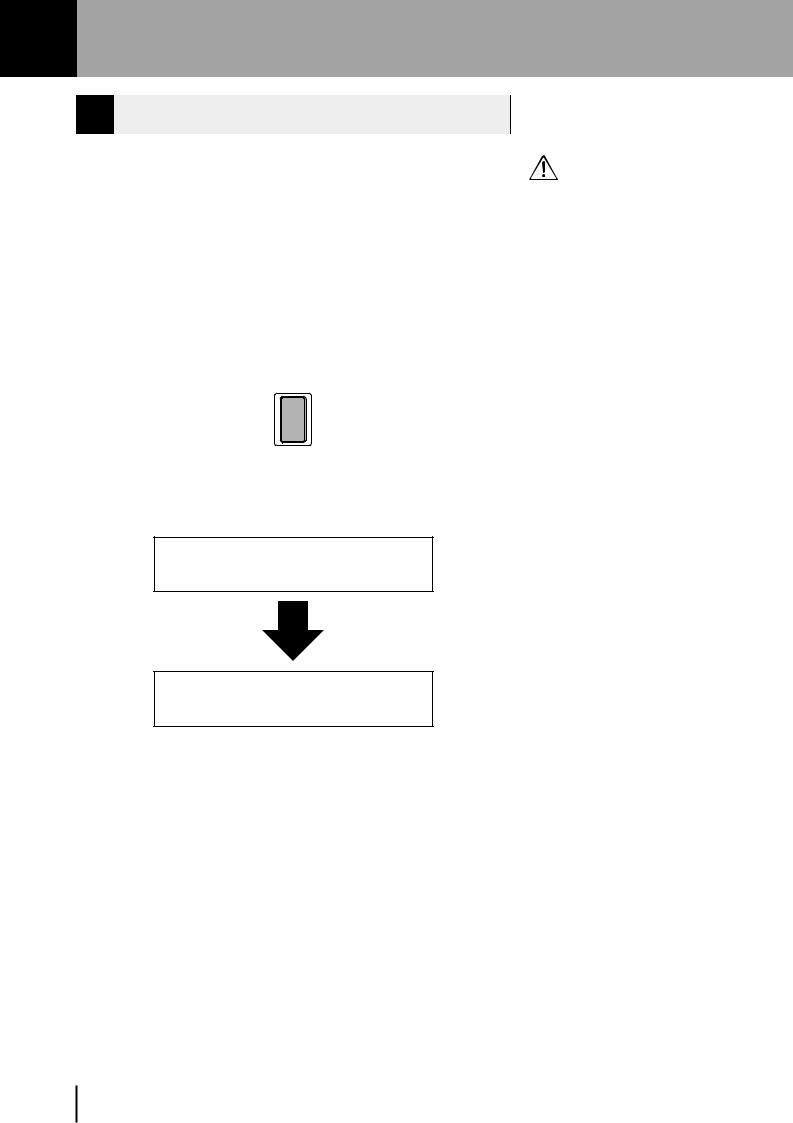
1 Quick Introductory Guide
1  Getting Started
Getting Started
1 Plug the power cord in to an appropriate electrical outlet.
Only use the voltage specified as correct for the Electone. The required voltage is printed on the name plate of the Electone. Yamaha products are manufactured specifically for the supply voltage in the area where they are to be sold. If you should move, or if any doubt exists about the supply voltage, please consult with a qualified technician.
2 |
Turn on the Electone by pressing the POWER switch. |
POWER |
When you turn on the Electone, the following displays will appear one after the other on the LCD display:
YAMAHA
Electone
¨⁄Strings1ÎViolin1 ⁄ Ò⁄Strings1∏⁄ContBs.1
This last display, Voice Display, shows you the currently assigned voice settings for each voice section.
When the Electone is turned on, Basic Registration 1 is automatically selected.
10
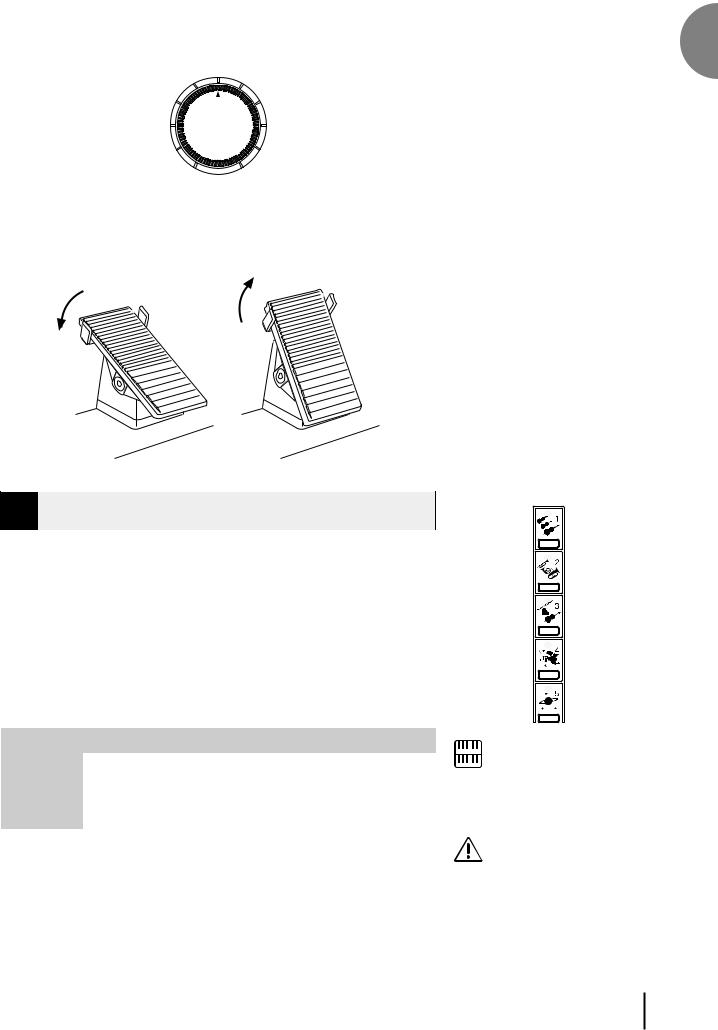
3 Set the MASTER VOLUME control.
The MASTER VOLUME control is an overall control which affects the volume of the entire instrument.
MASTER VOLUME
4 Press the Expression pedal down with your foot.
Once you have set the MASTER VOLUME control to a suitable level, you can use the Expression pedal to change the volume with your foot as you play.
Louder |
Softer |
2  Basic Registrations
Basic Registrations
“Registration” indicates a panel setting including upper keyboard voices, lower keyboard voices, pedal voices, a rhythm and so on. The Basic Registration section has five factory preset registrations, each with a different set of voices for Upper/Lower keyboards and Pedalboard and each specially suited for playing in a different music style.
To select Basic Registrations:
Press the BASIC REGIST. buttons to select each Basic Registration.
When you turn the power on, the Electone automatically selects Basic
Registration 1.
|
Basic |
Basic |
Basic |
Basic |
Basic |
|
|
Registration 1 |
Registration 2 |
Registration 3 |
Registration 4 |
Registration 5 |
|
|
|
|
|
|
|
|
Upper Keyboard |
Strings 1 |
Brass 1 |
Flute 1 |
Cosmic 1 |
Synth. Brass 1 |
|
Voice |
||||||
|
|
|
|
|
||
|
|
|
|
|
|
|
Lower Keyboard |
Strings 1 |
Horn1 |
Piano 1 |
Cosmic 2 |
Cosmic 3 |
|
Voice |
||||||
|
|
|
|
|
||
|
|
|
|
|
|
|
Pedal Voice |
Contra Bass1 |
Tuba |
Contra Bass 1 |
Cosmic 2 |
Synth. Bass 1 |
|
|
|
|
|
|
|
BASIC
REGIST.
NOTE:
Additional basic registrations are preset on the Registration Memory locations from 1 to 8. See page 67 for the details.
Turning the Electone off erases all panel settings you have made. When the Electone is turned on, Basic Registration 1 is automatically selected.
1
Guide Introductory Quick
11
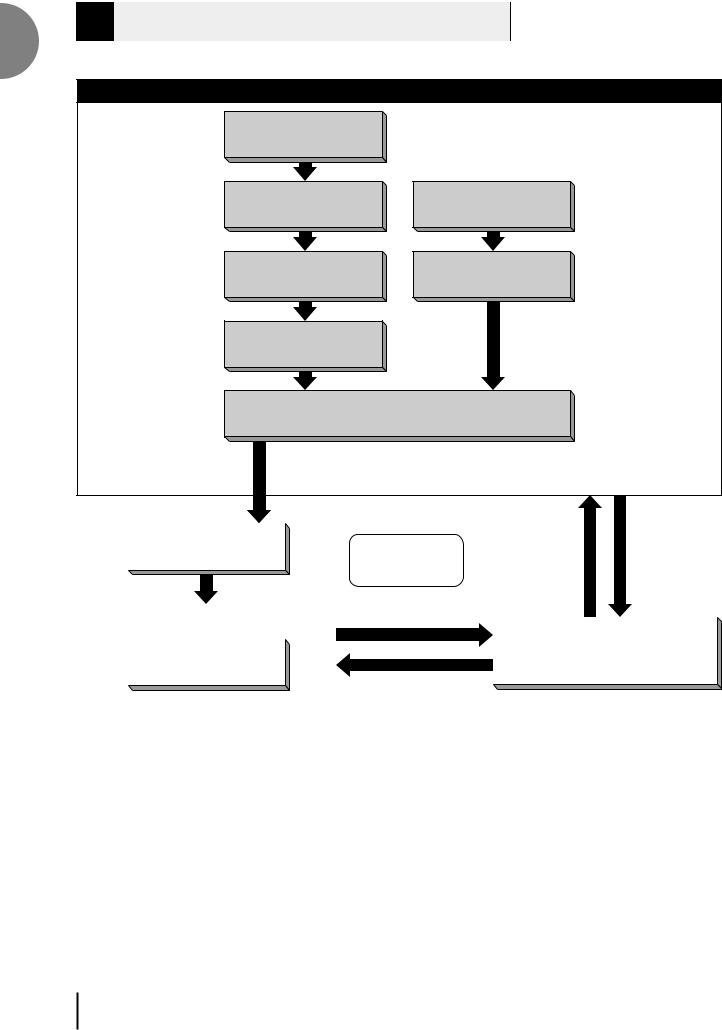
1
Guide Introductory Quick
3  Basic Operation
Basic Operation
Registration Set-up
*The Controls and Effects may be applied differently depending on the selected type of Controls and Effects. See page 29 for more information.
Select the keyboard to play
Select the voice (Voice Menu)
Finely adjust the voice (Voice Condition)
Add effects (Effect Set)
Select the rhythm (Rhythm Menu)
Finely adjust the rhythm (Rhythm Condition)
Add reverb
|
Adjust the total volume |
|
|
Loading the |
Saving the |
|
(Master Volume) |
|
Setting Registration |
registration data |
registration data |
|
|
|
Shift/Footswitch |
|
|
|
|
|
|
|
|
|
|
|
|
|
|
|
Playing Electone |
Recording the performance |
|
|
|
|
Music Disk Recorder |
||||
|
|
|
|
||
|
Expression Pedal |
|
|
||
|
|
|
|
|
|
|
|
|
Playing back |
|
|
|
|
|
|
|
|
12

4  LCD DISPLAY
LCD DISPLAY
This section introduces you the convenient control functions of the LCD display. The LCD display lets you see at a glance the current settings and provides easy-to-understand graphic representation of all parameters.
Selecting a voice/rhythm
Press the panel voice/rhythm button which you want to use (For |
||||||
example, press the STRINGS button in the Upper Keyboard Voice |
||||||
1 section). |
|
|
|
|
|
|
|
|
UPPER KEYBOARD VOICE |
|
|||
STRINGS |
BRASS |
CLARI- |
SAXO- |
CHORUS |
HARMO- |
MAX |
|
|
NET |
PHONE |
|
NICA |
|
ORGAN |
PIANO |
GUITAR |
VIBRA- |
COSMIC |
TUTTI |
|
|
|
|
PHONE |
|
|
|
MIN
The following display will appear, showing all the available voices/ rhythms in the category (Strings Category in this case).
DATA CONTROL |
DATA CONTROL |
Strings1 Strings2
Pizz.Strs Syn.Strs1
Press the Data Control button corresponding to the voice you want to |
|
2 play (Strings 2 in this case). |
|
DATA CONTROL |
DATA CONTROL |
Strings1 Strings2
Pizz.Strs Syn.Strs1
The first letter of the selected voice/rhythm will start blinking. For more information on the Voice Menu list see page 23.
1
Guide Introductory Quick
13
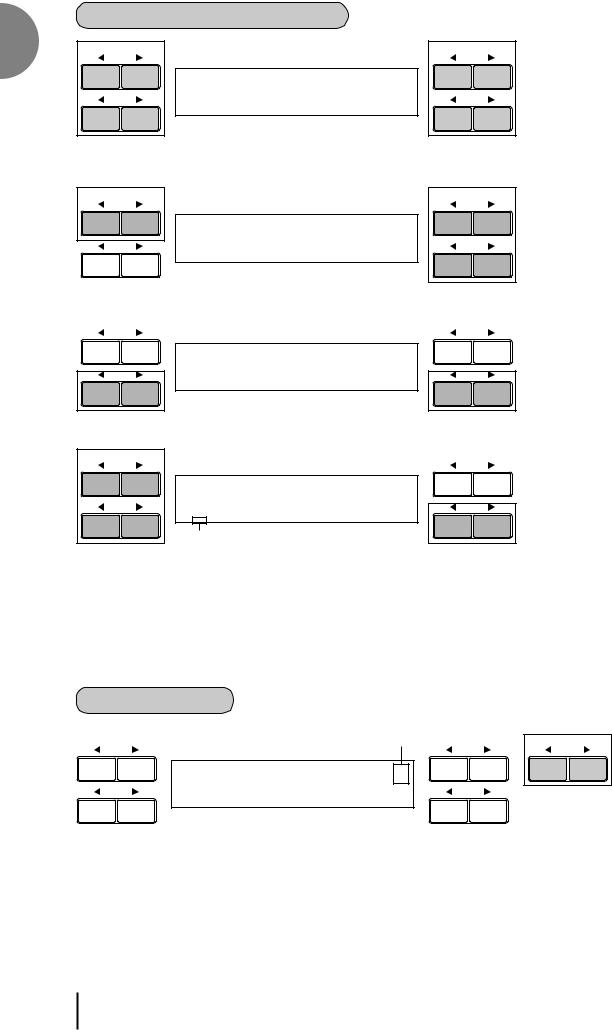
1 |
Function of the Data Control Buttons |
|
|
DATA CONTROL |
|
DATA CONTROL |
|
|
|
||
Quick |
Strings1 |
Strings2 |
|
Pizz.Strs Syn.Strs1 |
|||
Introductory |
1 |
|
1 |
|
|
||
Guide |
2 |
|
|
DATA CONTROL |
|
DATA CONTROL |
|
|
|
||
|
VOL.:24 |
PAN:C |
¨1¤ |
|
|
REVERB:24 |
|
|
|
|
2 |
|
DATA CONTROL |
|
DATA CONTROL |
3 |
EFFECT:SYMPHONIC ¨1‹ ”SYMPHONIC ’CELESTE
3 |
DATA CONTROL |
4 |
<R.SHIFT>[INS][DEL]¤ T_??????????????????
Cursor
DATA CONTROL
4 |
The Data Control buttons are used to select 1 a voice/rhythm or function shown on the display. Each pair of buttons corresponding to the section of the display directly above it increases/decreases 2 the value or chooses 3 a setting/function. When you are setting the Registration Shift, each of them moves the cursor 4 to the right/left.
Using Page Buttons
DATA CONTROL |
pages DATA CONTROL |
¨⁄Strings1ÎViolin1 ⁄ Ò⁄Strings1∏⁄ContBs.1
PAGE |
5 |
These buttons 5 are used to select (when available) the various ‘pages’ of the display, the names of which appear at the top right of the LCD. Use Page Fto select the next page, and Page Eto select the previous page.
14
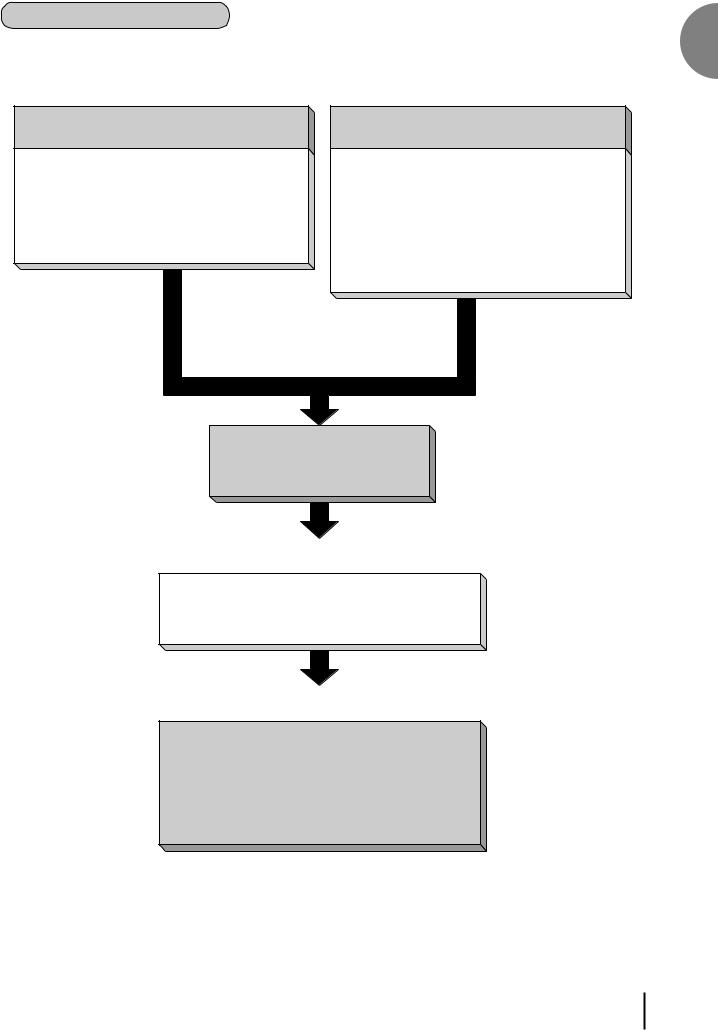
Summary of the LCD Operation
The following chart gives you a general view of the basic operations on the Electone.
1. To call up the LCD display
1)Pressing Panel Buttons
●Selecting voices or setting up the Voice Condition
●Selecting rhythms or setting up the Rhythm Condition
●Setting the Reverb effect
●Setting the Sustain
●Setting the User Keyboard Percussion
2)Pressing a Display Select button
●Displaying Voice Display (Manual Balance)
●Setting effects
●Setting A.B.C./M.O.C.
●Setting the Left-Footswitch
●Setting Registration Shift (Right-Footswitch)
●Setting Pitch and Transpose
●Setting MIDI
●Selecting and setting Tremolo/Chorus
LCD display
2. To Select Pages
Selecting the page you want to use with the Page buttons
3. To Actually Change the Settings
Using the Data Control buttons to:
●Select voices/rhythms/effects
●Turn on/off the Accompaniment and A.B.C. Memory
●Adjust Initial Touch and Reverb depth
●Move the pan position and cursor position
1
Guide Introductory Quick
15

1
Guide Introductory Quick
Language on the LCD
LCD display can be shown in two languages, English and Japanese.
How to select the language:
1.Press the VOICE DISPLAY button in the DISPLAY SELECT section. The page 1 will be displayed.
DISPLAY SELECT
VOICE |
EFFECT |
A.B.C. |
|
DISPLAY |
SET |
M.O.C. |
|
FOOT |
REGIST. |
PITCH |
TREMOLO |
SW. |
SHIFT |
MIDI |
(FAST) |
DATA CONTROL |
|
|
DATA CONTROL |
¨⁄Strings1ÎViolin1 ⁄ Ò⁄Strings1∏⁄ContBs.1
2. Press the PAGE button to select the page 3.
DATA CONTROL |
DATA CONTROL |
PAGE |
<v(4∂/Display> ‹ ’i-y∫ ”English
3.Pressing each pair of Page buttons at the bottom select the language: the right ones select English and the left ones select Japanese.
DATA CONTROL |
DATA CONTROL |
<v(4∂/Display> ‹ ’i-y∫ ”English
16
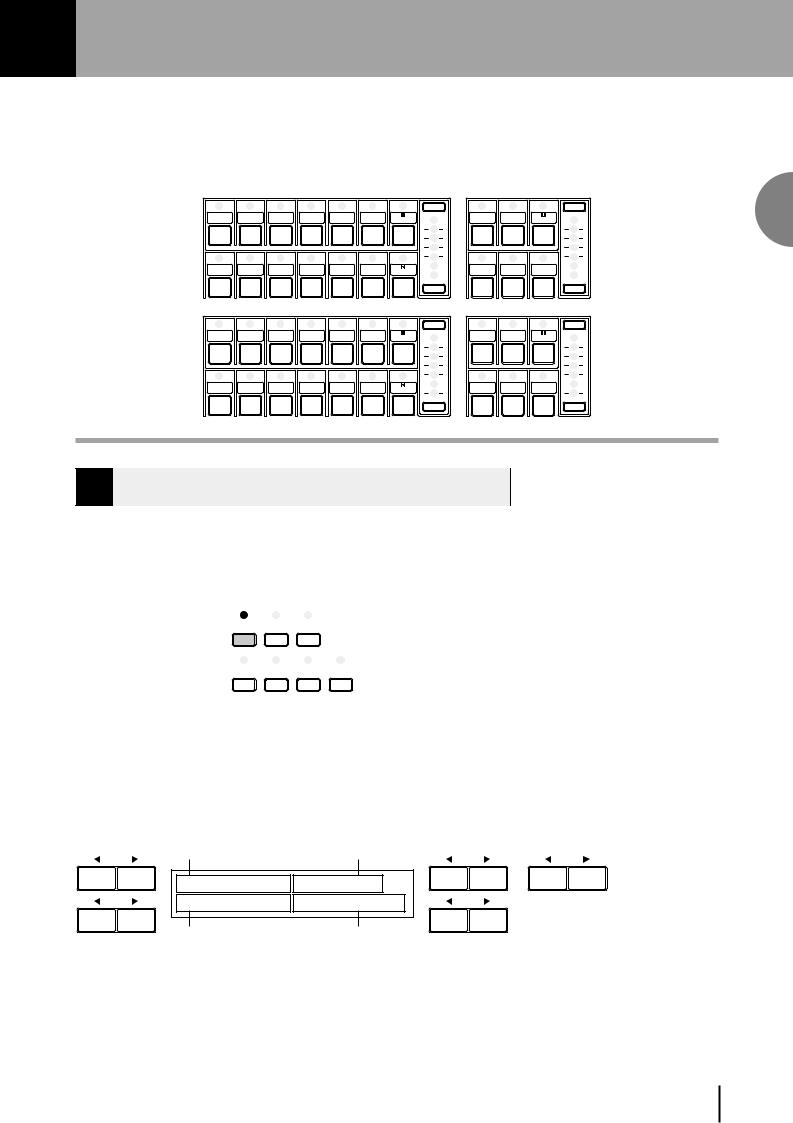
2 Voice Sections
The EL-100 features 173 different high quality AWM voices. Each of the AWM voices can be used on the Upper keyboard, Lower keyboard and Pedalboard. There are two voice sections for the Upper keyboard, one voice section for the Lower keyboard and Pedalboard, respectively.
Each voice section can, of course, have its own Voice Condition page(s), which allow you to finely set up voice and volume settings.
|
|
UPPER KEYBOARD VOICE |
|
|
LEAD VOICE |
||||
STRINGS |
BRASS |
CLARI- |
SAXO- |
CHORUS |
HARMO- |
MAX |
VIOLIN |
FLUTE |
MAX |
|
|
NET |
PHONE |
|
NICA |
|
|
|
|
ORGAN |
PIANO |
GUITAR |
VIBRA- |
COSMIC |
TUTTI |
|
OBOE |
TRUM- |
TO |
|
|
|
PHONE |
|
|
|
|
PET |
LOWER |
|
|
|
|
|
|
MIN |
|
|
MIN |
|
|
LOWER KEYBOARD VOICE |
|
|
PEDAL VOICE |
||||
STRINGS |
BRASS |
CLARI- |
SAXO- |
CHORUS |
HORN |
MAX |
CONTRA |
ELEC. |
MAX |
|
|
NET |
PHONE |
|
|
|
BASS |
BASS |
|
ORGAN |
PIANO |
GUITAR |
VIBRA- |
COSMIC |
TUTTI |
|
ORGAN |
TUBA |
TO |
|
|
|
PHONE |
|
|
|
BASS |
|
LOWER |
|
|
|
|
|
|
MIN |
|
|
MIN |
1  Voice Display
Voice Display
You can visually confirm the voice assignments to each keyboard.
Pressing the VOICE DISPLAY button in the DISPLAY SELECT section selects the Voice Display. (The Voice Display always appears when the Electone is turned on.)
DISPLAY SELECT
VOICE EFFECT A.B.C.
DISPLAY SET M.O.C.
FOOT |
REGIST. |
PITCH |
TREMOLO |
SW. |
SHIFT |
MIDI |
(FAST) |
The Voice Display is configured with three pages. Each page can be selected using the Page buttons.
Page 1 and 2 show the currently assigned voice settings for each voice section, as well as the overall balance between the Upper and Lower voices.
(page 1)
DATA CONTROL |
UPPER KEYBOARD VOICE |
LEAD VOICE |
DATA CONTROL |
PAGE |
|
|
|
¨⁄Strings1ÎViolin1 ⁄ Ò⁄Strings1∏⁄ContBs.1
LOWER KEYBOARD VOICE PEDAL VOICE
2
Sections Voice
17
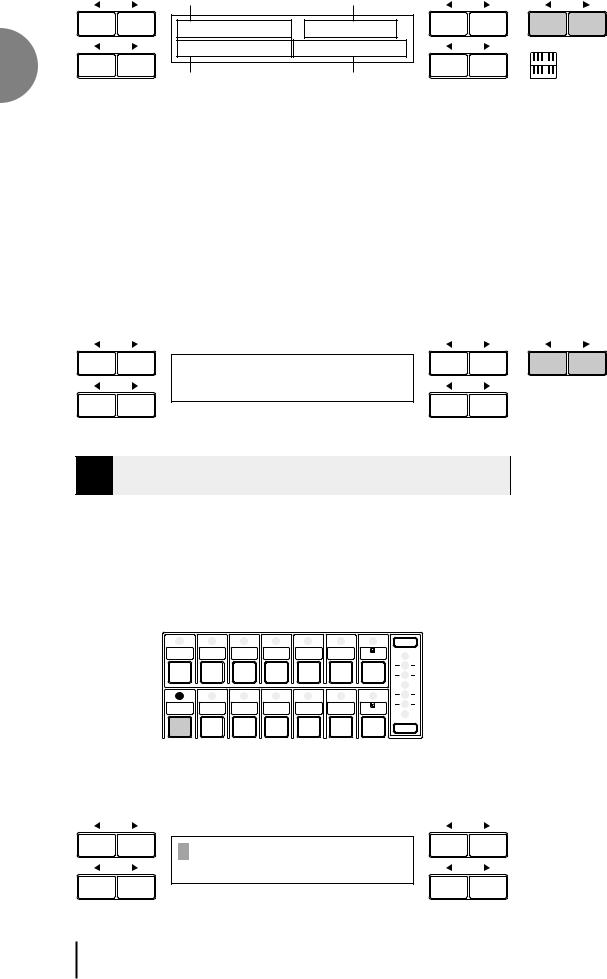
2
Sections Voice
(page 2)
|
|
Volume Balance |
|
|
DATA CONTROL |
UPPER KEYBOARD VOICE 2 |
between UPPER |
DATA CONTROL |
|
and LOWER (Page 20) |
||||
|
|
¨¤Strings1 M.BAL: 0¤ Ò¤Strings1∏¤ContBs.1
LOWER KEYBOARD VOICE 2 PEDAL VOICE 2
In addition to the four panel voice groups such as Upper Keyboard Voice, Lower Keyboard Voice, Pedal Voice and Lead Voice, the EL-100 has three “hidden” voice groups, Upper Keyboard Voice 2, Lower Keyboard Voice 2, Pedal Voice 2. These three voice groups are displayed on page 2 of the Voice Display screen. This fact indicates the EL-100 owns the same voice group numbers as those of the upper models like EL-500. Accordingly, the EL-100 can play back the registrations created with the upper models like EL-500. You can change the settings of each “hidden” voice group as you do with the panel voice groups. See page 27 for the details.
You can select the language shown on the LCD display on page 3 of the Voice Display (page 16).
PAGE
NOTE:
For more information on the volume balance between the Upper Keyboard and the Lower Keyboard see page 20.
DATA CONTROL |
DATA CONTROL |
PAGE |
<v(4∂/Display> ‹ ’i-y∫ ”English
2  Selecting Voices from the Panel
Selecting Voices from the Panel
Since selection of panel voices follows the same procedure throughout the various sections, instructions for only the Upper Keyboard Voice are given here.
1 |
Select a voice from the Upper Keyboard Voice section by pressing one |
||||||
of the Voice buttons in that section. |
|
|
|||||
|
|
UPPER KEYBOARD VOICE |
|
||||
|
STRINGS |
BRASS |
CLARI- |
SAXO- |
CHORUS |
HARMO- |
MAX |
|
|
|
NET |
PHONE |
|
NICA |
|
|
ORGAN |
PIANO |
GUITAR |
VIBRA- |
COSMIC |
TUTTI |
|
|
|
|
|
PHONE |
|
|
|
MIN
If, for example, you have selected the ORGAN voice, the following display (Voice Menu) will appear:
DATA CONTROL |
DATA CONTROL |
Organ1 JazzOrgan1
PopOrgan1 Accordion
Notice that several different voice names are shown on this display.
These are variations of the basic organ voice category.
18
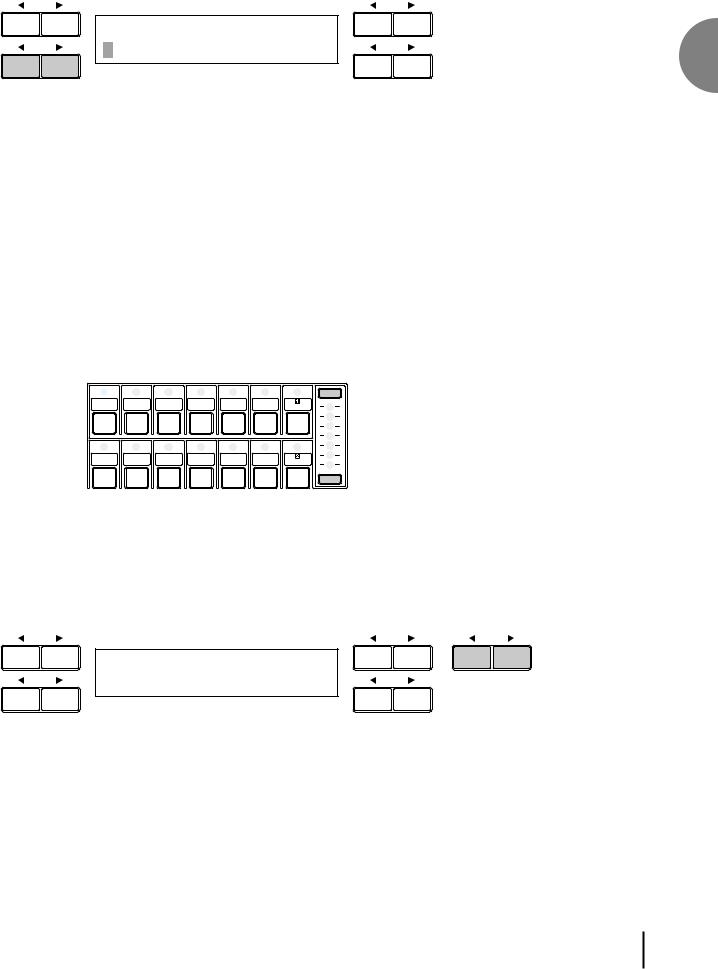
Press one of the Data Control buttons that corresponds to the voice you |
|
2 wish to select. (Pop Organ 1, in this case) |
|
DATA CONTROL |
DATA CONTROL |
Organ1 JazzOrgan1
PopOrgan1 Accordion
The first letter of the selected voice will start blinking. You have selected Pop Organ 1 for the Upper Keyboard Voice.
3 If you wish to, you can select voices from Lead Voice, Lower Keyboard Voice and Pedal Voice sections, following steps #1 and #2 above.
4 Set the volume for each voice section. There are two volume controls:
Coarse:
Use the VOLUME controls of each voice section on the panel to set the desired level for each voice. The controls have seven volume settings, from a minimum of 0, or no sound, to a maximum of full volume.
UPPER KEYBOARD VOICE
STRINGS |
BRASS |
CLARI- |
SAXO- |
CHORUS |
HARMO- |
MAX |
|
|
NET |
PHONE |
|
NICA |
|
ORGAN |
PIANO |
GUITAR |
VIBRA- |
COSMIC |
TUTTI |
|
|
|
|
PHONE |
|
|
|
|
|
|
|
|
|
MIN |
Fine:
Pressing the same panel voice button again (or the same Data Control button corresponding to the selected voice) calls up the Voice Condition display. Use the Page buttons to select page 2, which contains Volume setting.
DATA CONTROL |
DATA CONTROL |
PAGE |
INIT.T: 8 |
¨1⁄ |
|
|
FEET:PRESET |
|
2
Sections Voice
19
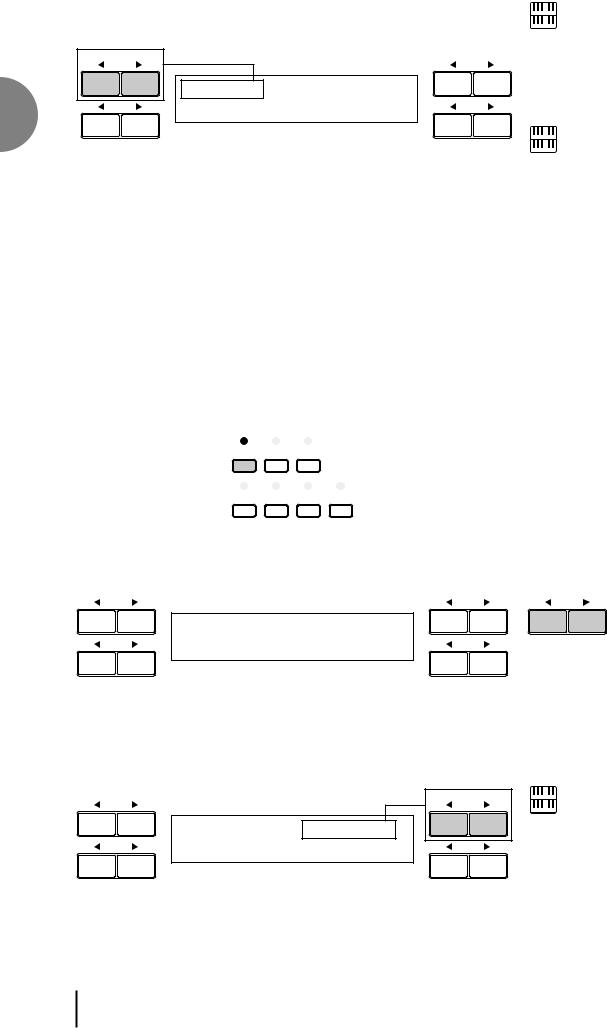
2
Sections Voice
Use the top left side Data Control button pair to change the level of the
desired voice. Fine volume settings, 0-24, are available.
DATA CONTROL |
|
DATA CONTROL |
VOL.:24 |
PAN:C |
¨1¤ |
|
REVERB:24 |
|
5 Now select voices for the Lower keyboard and Pedalboard as you did for the Upper keyboard above. Also set the volumes of the voices.
6 Adjust the volume balance between the Upper and Lower Voices with the Balance Control provided on the Voice Display.
To adjust the volume balance:
1.Press the VOICE DISPLAY button in the DISPLAY SELECT section. The Voice Display always appears when the Electone is
turned on.
DISPLAY SELECT
VOICE EFFECT A.B.C.
DISPLAY SET M.O.C.
FOOT |
REGIST. |
PITCH |
TREMOLO |
SW. |
SHIFT |
MIDI |
(FAST) |
2.Select page 2 of the Voice Display using Page buttons at the right side of the LCD display.
DATA CONTROL |
DATA CONTROL |
¨⁄Strings1ÎViolin1 ⁄ Ò⁄Strings1∏⁄ContBs.1
NOTE:
Pressing a voice button once calls up that voice’s Voice Menu display. Pressing it a second time calls up the Voice Condition display. Successive presses alternate between the two displays.
NOTE:
The Lead and Pedal Voices sound one note at a time; when you simultaneously press two or more keys, only the highest note will sound.
PAGE
3.Adjust the balance with the corresponding Data Control buttons, at the top right side. The positive values increase the Upper Keyboard volume, while the negative values lower it, or increase the Lower Keyboard volume. Range: -6 - +6
DATA CONTROL |
DATA CONTROL |
|
¨¤Strings1 M.BAL:+4¤ |
Ò¤Strings1∏¤ContBs.1
NOTE:
Pressing this pair of Data Control buttons at the same time restores the balance to the center position.
20
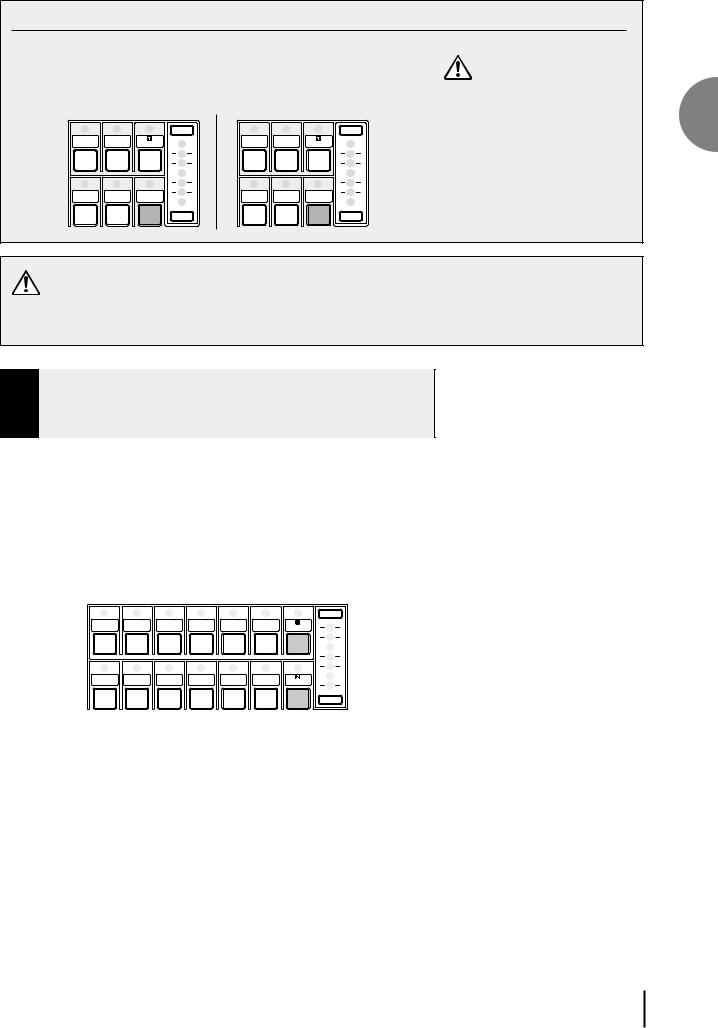
About TO LOWER - Playing (Upper) Lead Voice and Pedal Voice from the Lower keyboard:
The Electone has a special ‘To Lower’ function that lets you assign Lead or Bass voices to the Lower keyboard. Simply press the TO LOWER button on the voice section you wish to assign, and that voice will be playable from the Lower keyboard.
LEAD VOICE |
|
|
PEDAL VOICE |
|
VIOLIN FLUTE |
MAX |
CONTRA |
ELEC. |
MAX |
|
|
BASS |
BASS |
|
When the TO LOWER button is turned on, the Lead voices and Pedal voices cannot be played on the Upper keyboard and Pedalboard, respectively.
OBOE |
TRUM- |
TO |
ORGAN TUBA |
TO |
|
PET |
LOWER |
BASS |
LOWER |
|
|
MIN |
|
MIN |
Turning the Electone off erases all panel settings you have made. When the Electone is turned on, Basic Registration 1 is automatically selected. If you have made panel settings you wish to keep, save them to the floppy disk before turning the Electone off. See page 68 for more information.
2
Sections Voice
3 Selecting Voices from the Dotted Buttons
The EL-100 has a wide variety of voices from which you can choose – far greater than what is immediately apparent from the front panel controls. You’ve already learned in the section above how to select the different voices that are available in the Voice Menu display of each panel voice.
The Electone also has dotted buttons in each voice section, giving you access to even more voices. These dotted buttons function as ‘wild card’ Voice Menu selectors; any internal voices can be selected from these buttons.
UPPER KEYBOARD VOICE
STRINGS |
BRASS |
CLARI- |
SAXO- |
CHORUS |
HARMO- |
MAX |
|
|
NET |
PHONE |
|
NICA |
|
ORGAN |
PIANO |
GUITAR |
VIBRA- |
COSMIC |
TUTTI |
|
|
|
|
PHONE |
|
|
|
|
|
|
|
|
|
MIN |
The dotted buttons have two basic uses:
●For playing any voice of the Voice Menus from any of the keyboards or Pedalboard. You can play on the Upper keyboard, for example, voices from the twenty-two Voice Menu pages (including User), and not be limited to only the twelve buttons (equivalent to twelve Voice Menu pages) that make up the Upper Voice section. Another advantage to this feature is that when the normally monophonic (one note) Lead and Pedal voices are assigned to the Upper or Lower keyboard Voice sections, they can be played polyphonically.
●For having three different voices from the same Voice Menu page available for selection in the same song. For example, you can assign one of the voices to a dotted button in the Upper Keyboard Voice section, the second voice to the other dotted button in the same section, and the third one on the Voice Menu.
21
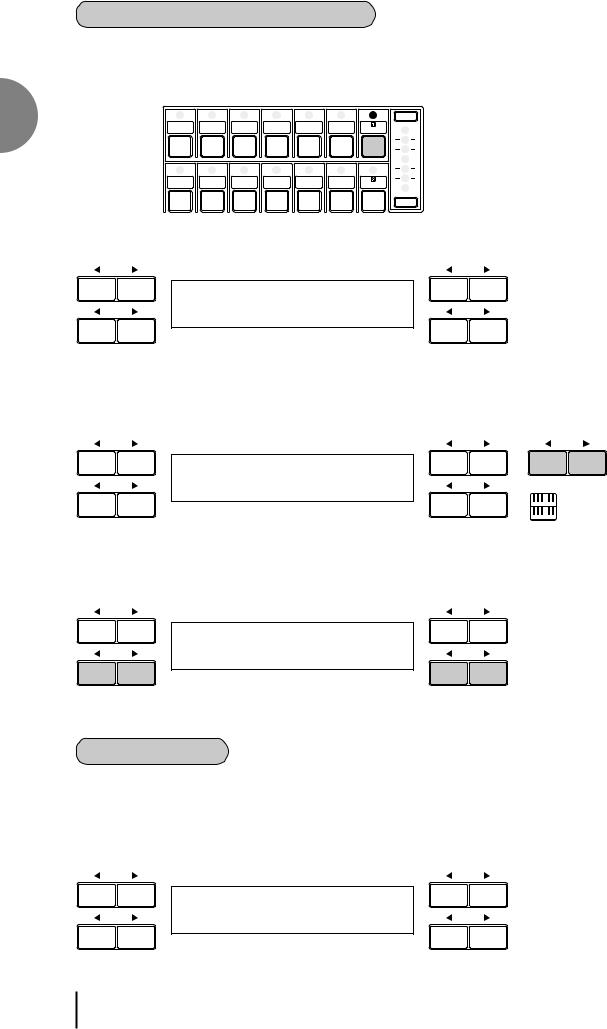
2
Sections Voice
To select voices from the dotted buttons:
Press one of the dotted buttons in any of the voice sections. |
||||||
Select Honky Tonk piano, for example, to the Dotted button 1 in Upper |
||||||
1 Keyboard Voice. |
|
|
|
|
|
|
|
|
UPPER KEYBOARD VOICE |
|
|||
STRINGS |
BRASS |
CLARI- |
SAXO- |
CHORUS |
HARMO- |
MAX |
|
|
NET |
PHONE |
|
NICA |
|
ORGAN |
PIANO |
GUITAR |
VIBRA- |
COSMIC |
TUTTI |
|
|
|
|
PHONE |
|
|
|
|
|
|
|
|
|
MIN |
STRINGS, Voice Menu 1, appears. |
|
|
||||
DATA CONTROL |
|
|
|
|
|
DATA CONTROL |
<STRINGS> ¨1‚⁄ 01:Strings1
Select one of the pages with the Page buttons, and choose a Voice |
|
2 Menu. (PIANO, page 17, in this case) |
|
DATA CONTROL |
DATA CONTROL |
<PIANO> ¨1⁄‡ 01:Piano1
3 Select 03: Honky Tonk piano voice using the Data Control buttons.
DATA CONTROL |
DATA CONTROL |
<PIANO> |
¨1⁄‡ |
03:Honky Tonk |
|
You have selected Honky Tonk for the Upper Keyboard Voice.
About User voices:
Page 22 is “User” area. Although EL-100 cannot exactly play back the user voices created with the upper models like EL-900, the automatic conversion function allows your EL-100 play back the voices fairly close to the original sounds. However, some voices may not be reproduced properly.
DATA CONTROL |
DATA CONTROL |
<USER VOICE> |
¨1¤¤ |
01:****** |
|
PAGE
NOTE:
You can directly view and select Voice Menu pages by holding down one of the Dotted buttons and simultaneously pressing the desired voice buttons in succession.
22
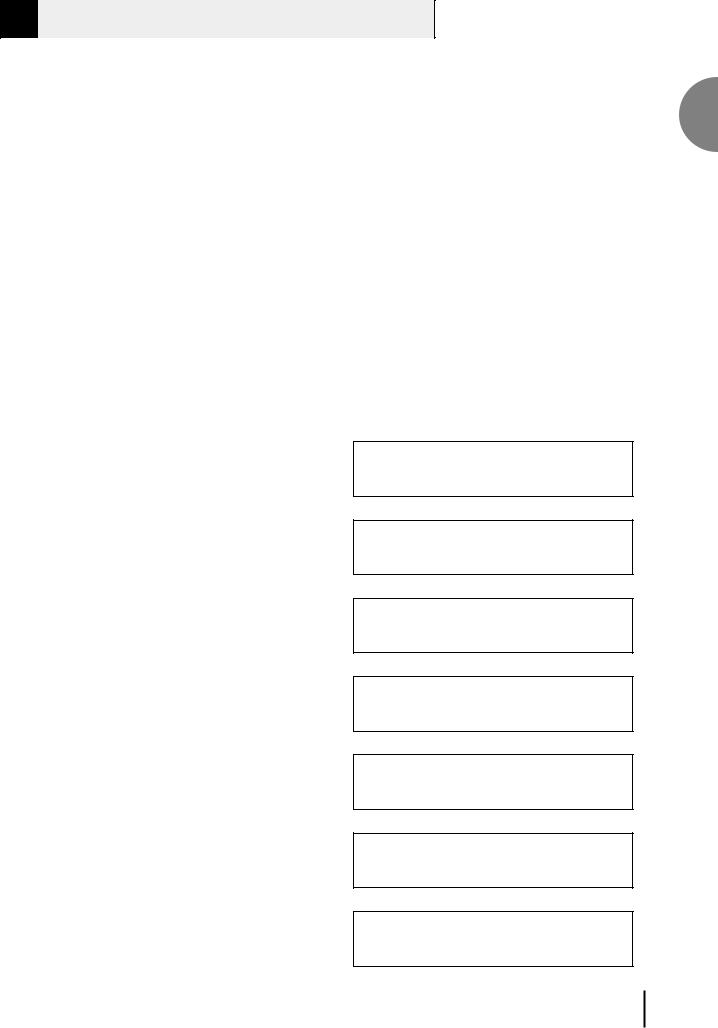
4  Voice Menus
Voice Menus
The following chart lists the voices that are shown by pressing the panel voice buttons. The other voices that are only available when using the Dotted buttons are shown on pages 24 - 26.
STRINGS Upper/Lower
Strings1 |
Strings2 |
Pizz.Strs |
Syn.Strs1 |
|
|
CONTRABASS Pedal |
|
|
|
ContBass1 |
ContBass2 |
Pizz.Bass |
UprghtBass |
HORN Lower |
|
|
|
Horn1 |
Horn2 |
Horn3 |
Huted Horn |
|
|
TUBA Pedal |
|
|
|
Tuba |
Timpani |
Timp.Roll |
|
|
|
OBOE Lead |
|
|
|
Oboe1 |
Oboe2 |
Bassoon1 |
EnglshHorn |
SAXOPHONE Upper/Lower |
|
|
|
Saxophon1 |
Saxophon2 |
Sopra.Sax |
Syn.Lead1 |
|
|
CHORUS Upper/Lower |
|
|
|
Chorus1 |
Chorus2 |
Chorus3 |
Vocal |
|
|
ORGAN Upper/Lower |
|
|
|
Organ1 |
JazzOrgan1 |
PopOrgan1 |
Accordion |
|
|
PIANO Upper/Lower |
|
|
|
Piano1 |
E.Piano1 |
E.Piano2 |
Harpsi. |
|
|
VIBRAPHONE Upper/Lower |
|
|
|
Vibrphone |
Glocken. |
Marimba |
Syn.Chime |
|
|
COSMIC Upper/Lower |
|
|
|
Cosmic1 |
Cosmic2 |
Cosmic3 |
Cosmic4 |
|
|
VIOLIN Lead
Violin1 |
Violin2 |
Cello |
PizzViolin |
|
|
BRASS Upper/Lower |
|
|
|
Brass1 |
Brass2 |
Brass3 |
Syn.Brass1 |
TRUMPET Lead |
|
|
|
Trumpet1 |
Trumpet2 |
Trombone1 Muted Trp |
|
|
|
FLUTE Lead |
|
|
|
Flute1 |
Piccolo |
Recorder |
Whistle |
|
|
CLARINET Upper/Lower
Clarinet1 Clarinet2
Bass Cla. Syn.Cla.1
TUTTI Upper/Lower
Tutti1 Tutti2
Tutti3 Tutti4
HARMONICA Upper
Harmoni.1 Harmoni.2
ORGAN BASS Pedal
Org.Bass1 Org.Bass2
Org.Bass3 Org.Bass4
GUITAR Upper/Lower
Guitar1 Guitar2
ElecGtr.1 Harp
ELECTRIC BASS Pedal
ElecBass1 ElecBass2
Syn.Bass1 Syn.Bass2
USER VOICE Upper/Lower/Pedal
<USER VOICE> 01:******
The details for each voice such as octave (feet) setting and effect on/off status are shown in the list on pages 24 - 26.
2
Sections Voice
23

2
Sections Voice
Details on All Voices |
|
The voices not lead by a bullet indicate that they are only selectable using the Dotted buttons. |
|||
|
|
|
|
|
|
Page/Section |
|
Voice Name |
Preset |
Comments |
|
|
Feet |
Effect |
|||
|
|
|
|
||
1. Upper/Lower |
● |
01: Strings 1 |
8' |
- |
Large strings ensemble. |
STRINGS |
|
|
|
|
|
● |
02: Strings 2 |
8' |
- |
Relatively small strings ensemble for contemporary music. |
|
|
|
03: Strings 3 |
8' |
- |
Small strings ensemble. |
|
|
|
|
|
|
|
|
04: Strings 4 |
8' |
- |
Having specific harmonics for layering other voices. |
|
|
|
|
|
|
|
|
05: Strings 5 |
8' |
- |
For legato playing. |
|
|
|
|
|
|
|
|
06: Strings 6 |
8' |
- |
Strings with clarity. Appropriate for the fast passages. |
|
|
07: Strings 7 |
8' |
- |
Expressive full bodied strings with a slow attack. |
|
|
|
|
|
|
|
● |
08: Pizz. Strings |
8' |
- |
Pizzicato strings. |
|
|
|
|
|
|
|
|
09: Trem. Strings |
8' |
- |
Tremolo strings. |
|
|
|
|
|
|
|
● 10: Synth. Strings 1 |
8' |
Cele. |
Synth. strings with softer attack. |
|
|
|
|
|
|
|
|
|
11: Synth. Strings 2 |
8' |
Sym. |
Bright synth. strings. |
|
|
|
|
|
|
|
|
12: Synth. Strings 3 |
8' |
Cele |
Softer Synth. strings. |
|
|
|
|
|
|
2. Lead |
● |
01: Violin 1 |
8' |
- |
For multi purposes. |
VIOLIN |
● |
02: Violin 2 |
8' |
- |
For solo with sharp attack. |
|
|
03: Violin 3 |
8' |
- |
Bright fidle for country music. |
|
|
|
|
|
|
|
|
04: Violin 4 |
8' |
- |
Darker synth. violin with wider dynamic range. |
|
|
|
|
|
|
|
|
05: Violin 5 |
8' |
- |
Violin with deep vibrato, also suited for chord playing. |
|
|
|
|
|
|
|
● |
06: Pizz. Violin |
8' |
- |
Pizzicato violin. |
|
|
|
|
|
|
|
● |
07: Cello |
8' |
- |
Cello with realistic rubbed string-instrument feel. |
|
|
|
|
|
|
|
|
08: Kokyu |
8' |
- |
Ancient Chinese fiddle. |
3. Pedal |
● |
01: Contrabass 1 |
8' |
- |
Standard type. |
CONTRABASS |
● |
02: Contrabass 2 |
8' |
- |
True-to-life tight contrabass sounding in an octave unison. |
|
|
03: Contrabass 3 |
16' |
- |
Realistic contrabass solo. |
|
|
|
|
|
|
|
● |
04: Pizz. Bass |
8' |
- |
Pizzicato contrabass for classicals. |
|
|
|
|
|
|
|
● |
05: Upright Bass |
8' |
- |
For jazz. |
|
|
|
|
|
|
4. Upper/Lower |
● |
01: Brass 1 |
8' |
- |
Trumpet and trombone ensemble for classicals. |
BRASS |
|
|
|
|
|
● |
02: Brass 2 |
8' |
- |
For big band with brighter attack. |
|
|
● |
03: Brass 3 |
8' |
- |
With strong impact. Can be used as orchestra hit. |
|
|
04: Brass 4 |
U16'/L8' |
- |
Trombone ensemble. |
|
|
|
|
|
|
|
|
05: Brass 5 |
8' |
- |
Tight octave brass for contemporary music. |
|
|
|
|
|
|
|
● 06: Synth. Brass 1 |
8' |
- |
Synth. brass with sharp attack. Used for Basic Regist. 5. |
|
|
|
|
|
|
|
|
|
07: Synth. Brass 2 |
8' |
- |
Analog type. Can be used as melody line. |
|
|
|
|
|
|
|
|
08: Synth. Brass 3 |
8' |
- |
Fat synth. brass. |
|
|
|
|
|
|
5. Lower |
● |
01: Horn 1 |
8' |
- |
Standard horn for classicals. |
HORN |
|
|
|
|
|
● |
02: Horn 2 |
8' |
- |
Horn unison solo. Alpenhorn. |
|
|
● |
03: Horn 3 |
8' |
- |
For solo playing. |
|
|
04: Horn 4 |
8' |
- |
Impressive horn ensemble. |
|
|
|
|
|
|
|
● |
05: Muted Horn |
8' |
- |
Muted horn. |
|
|
|
|
|
|
6. Lead |
● |
01: Trumpet 1 |
8' |
- |
Standard trumpet for classicals. |
TRUMPET |
|
|
|
|
|
● |
02: Trumpet 2 |
8' |
- |
Jazz trumpet 1 with full-bodied sounds. |
|
|
|
03: Trumpet 3 |
8' |
- |
Sweet voice. |
|
|
|
|
|
|
|
|
04: Trumpet 4 |
8' |
- |
Jazz trumpet 2 with a peculiar attack. |
|
|
|
|
|
|
|
|
05: Trumpet 5 |
8' |
- |
Comical synth. trumpet. |
|
|
06: Trumpet 6 |
8' |
- |
Resonant trumpet solo. |
|
|
|
|
|
|
|
● |
07: Muted Trp. |
8' |
- |
Harmon mute. |
|
|
|
|
|
|
|
● |
08: Trombone 1 |
U16'/L8' |
- |
For legato playing. |
|
|
|
|
|
|
|
|
09: Trombone 2 |
U16'/L8' |
- |
Bright trombone solo. For fast phrases. |
|
|
|
|
|
|
|
|
10: Muted Trb. |
U16'/L8' |
- |
Cup mute. |
|
|
|
|
|
|
|
|
11: Flugel Horn |
8' |
- |
Flugelhorn. |
|
|
|
|
|
|
|
|
12: Euphonium |
U16/L8 |
- |
Euphonium with softer sounds. |
7. Pedal |
● |
01: Tuba |
16' |
- |
Accentuated by touch. |
TUBA |
● |
02: Timpani |
8' |
- |
Standard timpani. |
|
● |
03: Timpani Roll |
8' |
- |
Typical timpani roll. |
|
|
|
|
|
|
8. Lead |
● |
01: Flute 1 |
8' |
- |
Standard flute solo. |
FLUTE |
|
|
|
|
|
|
02: Flute 2 |
8' |
- |
For legato playing. |
|
|
● |
03: Piccolo |
4' |
- |
Standard piccolo. |
|
|
|
|
|
|
|
|
04: Yokobue |
4' |
- |
Japanese pipe with clear sounds. |
|
|
|
|
|
|
|
● |
05: Recorder |
4' |
- |
Block floete. |
|
|
06: Ocarina |
4' |
- |
Ocarina with simple but warm sounds. |
|
|
|
|
|
|
|
|
07: Pan Flute |
8' |
- |
Pan Flute. |
|
|
|
|
|
|
|
|
08: Shakuhachi |
8' |
- |
Japanese Shakuhachi with realistic breath noises. |
|
|
|
|
|
|
|
● |
09: Whistle |
4' |
- |
Whistle. |
|
|
|
|
|
|
24

Page/Section |
|
Voice Name |
Preset |
Comments |
|
|
Feet |
Effect |
|||
|
|
|
|
||
9. Lead |
● |
01: Oboe 1 |
8' |
- |
Softer oboe. |
OBOE |
|
|
|
|
|
● |
02: Oboe 2 |
8' |
- |
Rounder tone with characteristic tonguing. For fast phrases. |
|
|
● |
03: English Horn |
8' |
- |
Cor Anglais. |
|
|
|
|
|
|
|
● |
04: Bassoon 1 |
U16'/L8' |
- |
For legato playing. |
|
|
|
|
|
|
|
|
05: Bassoon 2 |
U16'/L8' |
- |
For staccato playing. |
|
|
|
|
|
|
10. Upper/Lower |
● |
01: Clarinet 1 |
8' |
- |
Standard clarinet. |
CLARINET |
● |
02: Clarinet 2 |
8' |
- |
Clarinet solo for jazz and contemporary. |
|
● |
03: Bass Cla. |
8' |
- |
Bass clarinet with fat and resonant sounds. |
|
|
|
|
|
|
|
● 04: Synth. Cla. 1 |
8' |
- |
Resonant synth. clarinet. |
|
|
|
|
|
|
|
|
|
05: Synth. Cla. 2 |
8' |
- |
Synth. reed with a unique attack sound. |
|
|
|
|
|
|
11. Upper/Lower |
● |
01: Saxophone 1 |
U16'/L8' |
- |
Alto sax. |
SAXOPHONE |
|
|
|
|
|
● |
02: Saxophone 2 |
U16'/L8' |
- |
Characteristic tenor sax with strong tonguing. |
|
|
● |
03: Sopra. Sax. |
8' |
- |
Standard soprano sax. |
|
|
04: Sax. Ens. 1 |
U16'/L8' |
- |
Softer sounds for classicals. |
|
|
|
|
|
|
|
|
05: Sax. Ens. 2 |
U16'/L8 |
- |
Saxophone section for bigband. |
|
|
|
|
|
|
|
|
06: Synth. Sax. |
8' |
- |
Wind synthesizer with thick sounds in the middle and lower range. |
|
|
|
|
|
|
|
● 07: Synth. Lead 1 |
8' |
- |
Softer analog synth. reed. |
|
|
|
|
|
|
|
|
|
08: Synth. Lead 2 |
8' |
- |
Clear synth. reed with a sharp attack. |
|
|
|
|
|
|
|
|
09: Synth. Lead 3 |
4' |
- |
Hoarse noise reed. |
|
|
|
|
|
|
|
|
10: Synth. Lead 4 |
8' |
- |
Digital synth. reed. |
|
|
11: Synth. Lead 5 |
8' |
- |
Synth. reed with thick fourth notes. |
12. Upper/Lower |
● |
01: Tutti 1 |
8' |
- |
Strings unison and wood winds ensemble. |
TUTTI |
|
|
|
|
|
● |
02: Tutti 2 |
8' |
- |
Strings unison and the brasses. |
|
|
● |
03: Tutti 3 |
8' |
- |
The brasses for classicals and bands. |
|
|
|
|
|
|
|
● |
04: Tutti 4 |
8' |
- |
Big band. Softer playing = sax only. Harder playing = 1 octave higher brasses added. |
|
|
|
|
|
|
|
|
05: Tutti 5 |
8' |
- |
Wood winds ensemble. Instruments vary depending on the register played. |
|
|
|
|
|
|
|
|
06: Tutti 6 |
8' |
- |
Wood winds quintet. |
|
|
|
|
|
|
|
|
07: Tutti 7 |
8' |
- |
Brass ensemble. |
13. Upper/Lower |
● |
01: Chorus 1 |
8' |
- |
Female “Ah”. |
CHORUS |
|
|
|
|
|
● |
02: Chorus 2 |
8' |
- |
Male “Wh”. |
|
|
● |
03: Chorus 3 |
8' |
- |
Mixed chorus. |
|
|
|
|
|
|
|
|
04: Chorus 4 |
8' |
- |
Mixed chorus with beautiful resonance. Wh. |
|
|
|
|
|
|
|
|
05: Chorus 5 |
8' |
- |
Scat type vocal ensemble. |
|
|
|
|
|
|
|
● |
06: Vocal |
8' |
- |
Accentuated solo vocal, “Ah”. |
|
|
|
|
|
|
14. Upper |
● |
01: Harmonica 1 |
8' |
- |
Standard type with pitch modulated vibrato. |
HARMONICA |
● |
02: Harmonica 2 |
8' |
- |
Solo harmonica with filter and amplitude modulated vibrato. |
15. Upper/Lower |
● |
01: Organ 1 |
8' |
- |
Small pipe organ. 8'. |
ORGAN |
|
|
|
|
|
|
02: Organ 2 |
8' |
- |
Big pipe organ with full coupler. |
|
|
|
03: Organ 3 |
8' |
- |
Nasard stops. 8'+2 2/3'. |
|
|
|
|
|
|
|
|
04: Organ 4 |
8' |
- |
Harmonium. |
|
|
|
|
|
|
|
● 05: Jazz Organ 1 |
16' |
Chor. |
For solo playing. 16'+8'+5 1/3'. |
|
|
|
|
|
|
|
|
|
06: Jazz Organ 2 |
16' |
Trem. |
16'+8'+2'. |
|
|
|
|
|
|
|
|
07: Jazz Organ 3 |
16' |
Trem. |
For cluster playing. 16'+1 3/5'+1 1/3'+1'. |
|
|
08: Jazz Organ 4 |
16' |
Chor. |
Fat and noisy jazz organ. |
|
|
|
|
|
|
|
● 09: Pop Organ 1 |
8' |
Chor. |
Bright sounds for jazz. 8'+4'+2 2/3'. |
|
|
|
|
|
|
|
|
|
10: Pop Organ 2 |
8' |
Chor. |
For multi purposes. |
|
|
|
|
|
|
|
|
11: Theat. Organ 1 |
8' |
Sym. |
8'+4' with slower attack. |
|
|
|
|
|
|
|
|
12: Theat. Organ 2 |
8' |
- |
16'+8' with slower attack. |
|
|
|
|
|
|
|
● |
13: Accordion |
8' |
- |
Slower attack. |
|
|
|
|
|
|
|
|
14: Bandoneon |
8' |
- |
Attack can be controlled by initial touch. |
16. Pedal |
● |
01: Organ Bass 1 |
8' |
- |
Combination organ bass. |
ORGAN BASS |
● |
02: Organ Bass 2 |
16' |
- |
Pipe organ bass 1. Standard type. |
|
● 03: Organ Bass 3 |
16' |
- |
For jazz. 16'. |
|
|
|
|
|
|
|
|
● 04: Organ Bass 4 |
16' |
- |
Pipe organ bass 2. Full coupler. |
|
|
|
|
|
|
|
17. Upper/Lower |
● |
01: Piano 1 |
8' |
- |
For multi purposes. |
PIANO |
|
|
|
|
|
|
02: Piano 2 |
8' |
- |
Brighter sounds. CP80 type. |
|
|
|
03: Honkytonk |
8' |
- |
Honky tonk piano. |
|
|
|
|
|
|
|
● 04: Elec. Piano 1 |
8' |
Cele. |
DX7 type. |
|
|
● 05: Elec. Piano 2 |
8' |
Cele. |
Old fashioned, full bodied electric piano. |
|
|
|
|
|
|
|
|
|
06: Elec. Piano 3 |
8' |
- |
Electric piano with clearly brilliant but deep sounds. |
|
|
|
|
|
|
|
● |
07: Harpsichord |
8' |
- |
Standard cembalo. |
|
|
|
|
|
|
|
|
08: Clavi. |
16' |
- |
Funky clavi. |
|
|
|
|
|
|
|
|
09: Clavichord |
8' |
- |
Clavichord with stable and grave sounds. |
2
Sections Voice
25

2
Sections Voice
Page/Section |
|
Voice Name |
Preset |
Comments |
|
|
Feet |
Effect |
|||
|
|
|
|
||
18. Upper/Lower |
● |
01: Guitar 1 |
U16'/L8' |
- |
Folk guitar. Steel string. |
GUITAR |
|
|
|
|
|
● |
02: Guitar 2 |
U16'/L8' |
- |
Acoustic jazz guitar. Tone varies depending on the touch. |
|
|
|
03: Guitar 3 |
U16'/L8' |
- |
Classic guitar. Suitable to backing for bossanova. |
|
|
|
|
|
|
|
|
04: 12Str. Guitar |
U16/L8 |
- |
12-string classic guitar with gorgeous sounds. |
|
|
|
|
|
|
|
|
05: Banjo |
8' |
- |
For country and dixieland. |
|
|
|
|
|
|
|
|
06: Mandolin |
8' |
Cele. |
Standard mandolin. |
|
|
07: Sitar |
8' |
- |
Indian sitar with the different resonances between lower and mid./high ranges. |
|
|
|
|
|
|
|
|
08: Shamisen |
8' |
- |
Japanese classical shamisen. |
|
|
|
|
|
|
|
● 09: Elec. Guitar 1 |
U16'/L8' |
- |
For backing. |
|
|
|
|
|
|
|
|
|
10: Elec. Guitar 2 |
U16'/L8' |
- |
For solo playing. |
|
|
|
|
|
|
|
|
11: Muted Guitar |
U16'/L8' |
- |
Muted guitar. |
|
|
|
|
|
|
|
|
12: Dist. Guitar |
U16'/L8' |
- |
Distorted guitar. |
|
|
|
|
|
|
|
● |
13: Harp |
8' |
- |
Grand harp. |
|
|
14: Steel Guitar |
8' |
- |
Hawaiian guitar. Effective when used with the glide function. |
|
|
|
|
|
|
|
|
15: Koto |
8' |
- |
Japanese Koto. |
|
|
|
|
|
|
|
|
16: Taisho Koto |
4' |
Cele. |
Japanese Taisho Koto. |
|
|
|
|
|
|
19. Upper/Lower |
● |
01: Vibraphone |
8' |
- |
Standard vibraphone. |
VIBRAPHONE |
|
|
|
|
|
● |
02: Glocken |
4' |
- |
Glockenspiel. |
|
|
|
03: Celesta |
4' |
- |
Celesta. |
|
|
|
|
|
|
|
|
04: Music Box |
4' |
- |
Antique music box. |
|
● |
05: Marimba |
8' |
- |
Concert marimba. |
|
|
06: Xylophone |
4' |
- |
Tone varies depending on the initial touch. |
|
|
|
|
|
|
|
|
07: Chime |
4' |
- |
Chime. |
|
|
|
|
|
|
|
● |
08: Synth. Chime |
8' |
Cele. |
Starry chime. |
|
|
|
|
|
|
|
|
09: Steel Drum |
8' |
- |
Steel Drum. |
|
|
|
|
|
|
20. Pedal |
● |
01: Elec. Bass 1 |
8' |
- |
For multi purposes. |
ELECTRIC BASS |
|
|
|
|
|
● |
02: Elec. Bass 2 |
16' |
- |
Slap bass. |
|
|
|
03: Elec. Bass 3 |
16' |
- |
Plucked bass with hard attack. |
|
|
04: Elec. Bass 4 |
16' |
Cele. |
Fretless bass, also suited for solo playing. |
|
|
|
|
|
|
|
● 05: Synth. Bass 1 |
16' |
- |
Sustained sounds. |
|
|
|
|
|
|
|
|
● 06: Synth. Bass 2 |
16' |
- |
With remarkable attack. |
|
|
|
|
|
|
|
|
|
07: Synth. Bass 3 |
16' |
- |
Tone varies depending on the touch. |
|
|
|
|
|
|
21. Upper/Lower |
● |
01: Cosmic 1 |
4' |
- |
Decay type. For multi purposes. UK in Basic Regist. 4. |
COSMIC |
|
|
|
|
|
● |
02: Cosmic 2 |
8' |
- |
The lower register of celesta. LK and PK in Basic Regist. 4. |
|
|
● |
03: Cosmic 3 |
8' |
- |
Brass type.LK in Basic Regist. 5. |
|
● |
04: Cosmic 4 |
8' |
- |
Decay type. With fantastic image. |
|
|
05: Cosmic 5 |
8' |
- |
Spacious sounds with feedback. |
|
|
|
|
|
|
|
|
06: Cosmic 6 |
8' |
- |
Synth. brass type. |
|
|
|
|
|
|
|
|
07: Cosmic 7 |
8' |
- |
Vocal type with feedback. |
|
|
|
|
|
|
|
|
08: Cosmic 8 |
8' |
- |
Distortion type with feedback. |
|
|
|
|
|
|
|
|
09: Cosmic 9 |
8' |
- |
Decay type with unique feedback. |
|
|
|
|
|
|
|
|
10: Cosmic 10 |
8' |
- |
Clear synth. pad. |
|
|
|
|
|
|
|
|
11: Cosmic 11 |
8' |
- |
Digital synth. pad. |
|
|
12: Cosmic 12 |
8' |
- |
Chorus type synth. pad. |
|
|
|
|
|
|
|
|
13: Cosmic 13 |
8' |
- |
Special sound effect with a slower attack. The sounds drastically changes. |
|
|
|
|
|
|
|
|
14: Cosmic 14 |
8' |
- |
Fantastic digital music box. |
|
|
|
|
|
|
|
|
15: Cosmic 15 |
8' |
- |
Ethnic synth. percussion. |
|
|
|
|
|
|
|
|
16: Cosmic 16 |
16' |
- |
Special sound effect with a complicated mixture of various sounds. |
Some of the voices may be different from the ones on the upper models like EL-900 even if they have the same voice names.
26
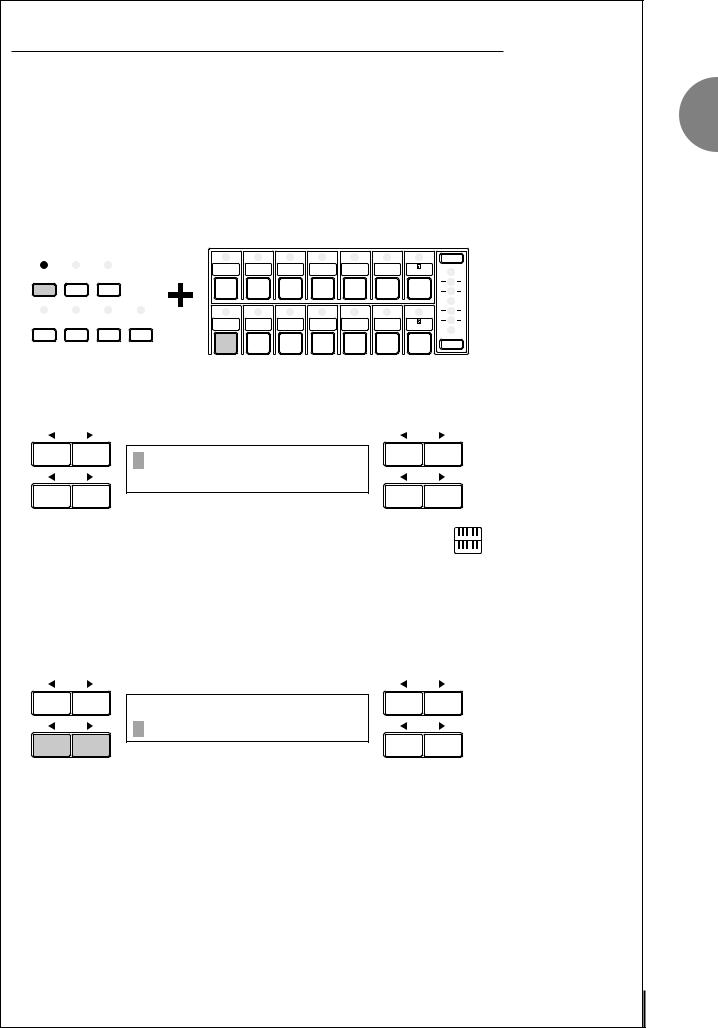
To select the “hidden” voices
(Upper Keyboard Voice 2, Lower Keyboard Voice 2 and Pedal Voice 2):
You can call up the “hidden” voices on the LCD display and select them. This function allows you to layer the voices on each keyboard to make the sound thicker.
The procedure is explained with the selection of Upper Keyboard Voice 2, as an example.
1.Press one of the voice buttons in the Upper Keyboard Voice section while holding down the VOICE DISPLAY button in the DISPLAY SELECT section.
|
|
|
|
|
|
UPPER KEYBOARD VOICE |
|
|||
|
DISPLAY SELECT |
|
|
|
|
|
|
|
||
|
|
|
|
STRINGS |
BRASS |
CLARI- |
SAXO- |
CHORUS |
HARMO- |
MAX |
VOICE |
EFFECT |
A.B.C. |
|
|
|
NET |
PHONE |
|
NICA |
|
DISPLAY |
SET |
M.O.C. |
|
|
|
|
|
|
|
|
FOOT |
REGIST. |
PITCH |
TREMOLO |
ORGAN |
PIANO |
GUITAR |
VIBRA- |
COSMIC |
TUTTI |
|
SW. |
SHIFT |
MIDI |
(FAST) |
|
||||||
|
|
|
PHONE |
|
|
|
||||
|
|
|
|
|
|
|
|
|
|
|
MIN
If, for example, you have selected the ORGAN voice, the following
display (Voice Menu) will appear:
DATA CONTROL |
DATA CONTROL |
Organ1 JazzOrgan1
PopOrgan1 Accordion
Notice that several different voice names are shown on this display.
NOTE:
These are variations of the basic organ category.
In this case the lamp on/off status in the Upper Keyboard Voice section will not be affected since you are dealing with the Upper Keyboard Voice 2.
2.Press one of the Data Control buttons that corresponds to the voice you wish to select. (Pop Organ 1, in this case)
DATA CONTROL |
DATA CONTROL |
Organ1 JazzOrgan1
PopOrgan1 Accordion
The first letter of the selected voice will start blinking. You have selected Pop Organ 1 for the Upper Keyboard Voice 2.
27
2
Sections Voice
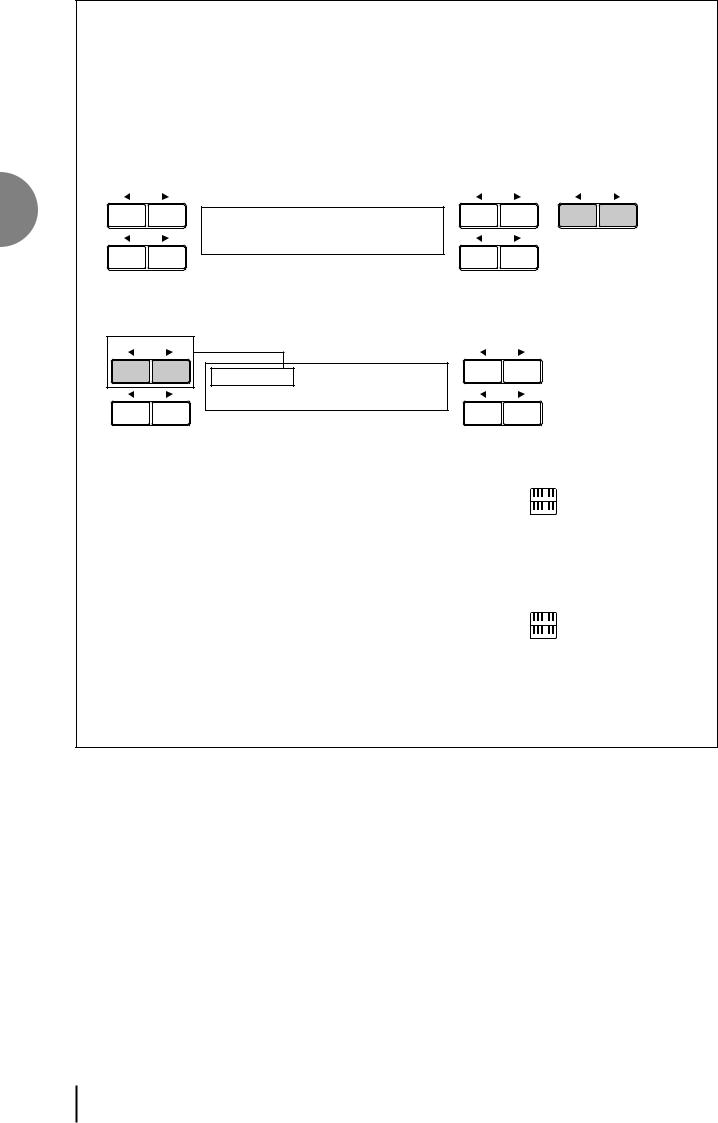
2
Sections Voice
3.Set the volume for the Upper Keyboard Voice 2.
Pressing the same Data Control button corresponding to the selected voice calls up the Voice Condition display. Use the Page buttons to select page 2, which contains Volume setting.
DATA CONTROL |
DATA CONTROL |
PAGE |
INIT.T: 8 |
¨2⁄ |
|
|
FEET:PRESET |
|
Use the top left side Data Control button pair to change the level of the
desired voice.
DATA CONTROL |
|
DATA CONTROL |
VOL.:24 |
PAN:C |
¨2¤ |
|
REVERB:24 |
|
You can select the voices of Lower Keyboard Voice 2 and Pedal Voice
2 in the same manner.
NOTE:
Also, you can change the volume of the Upper Keyboard Voice 2 voices by pressing the Upper Keyboard Voice volume buttons on the panel while holding VOICE DISPLAY button.
NOTE:
The panel volume lamp position will not be affected even if you change the volume of Upper Keyboard Voice 2. The volume buttons on the panel are exclusive for the panel voice groups.
28
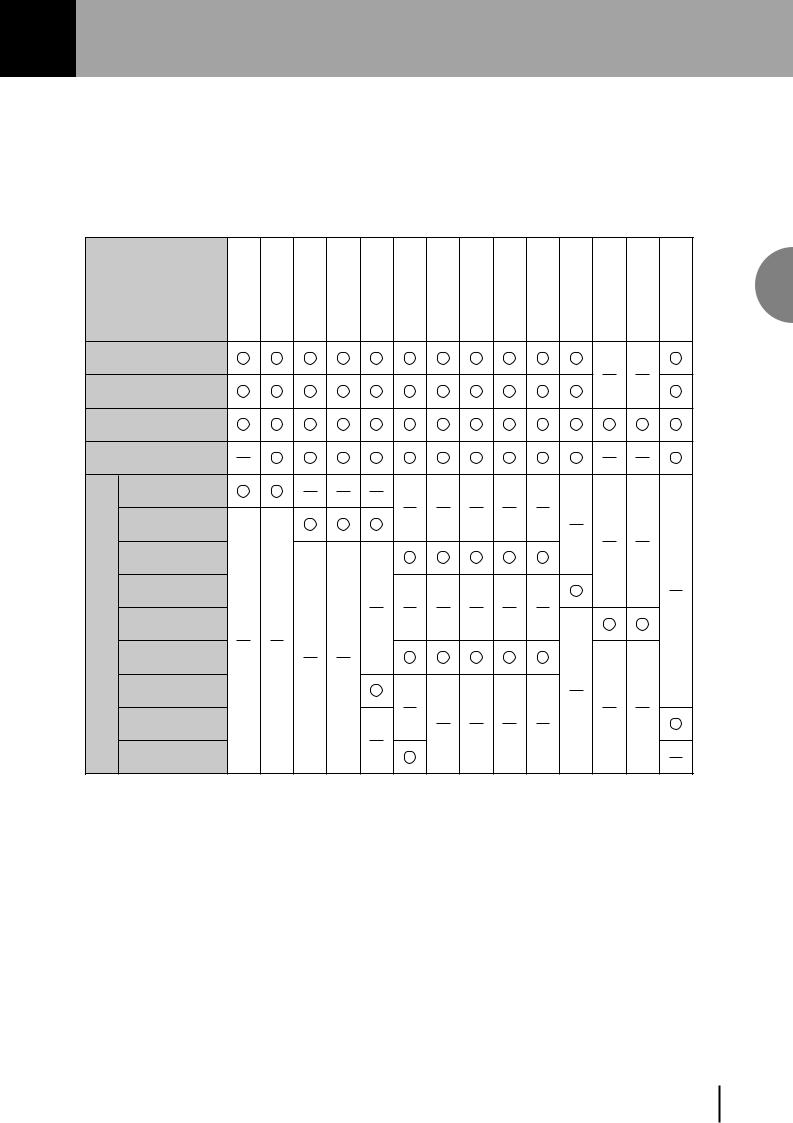
3 Voice Controls and Effects
The Electone is equipped with two general kinds of functions that can be used to change the sound of the voices: Voice Controls and Effects.
Certain effects may have been applied to some of the voices, but can be modified as you like. All built-in effects are digital.
The chart below shows the various voice controls and effects for the individual voice sections. Available functions are indicated by circles. The controls and effects are differently applied depending on those types: applied to each voice group, to each keyboard or to the entire system.
Inital |
|
Reverb |
Tremolo |
Sym- |
Lead |
Lead |
|
Feet Volume Pan |
/Chorus |
phonic/ Delay Flanger Distortion Vibrato |
Sustain |
||||
Touch |
|
*2 |
*1 |
Celeste |
Slide |
Tune |
|
|
|
|
|
|
|
||
|
|
|
|
|
|
|
|
Upper Keyboard Voice
Lower Keyboard Voice
Lead Voice
|
Pedal Voice |
|
|
Voice Condition Page 1 |
|
|
Voice Condition Page 2 |
|
|
Voice Condition Page 3 |
|
Related |
Voice Condition Page 4 |
|
Voice Condition Page 5 |
||
Pages |
(Lead Voice only) |
|
Effect Set Page |
||
|
||
|
Reverb Page |
|
|
Sustain Page |
|
|
Tremolo Page |
*1 Turning tremolo/chorus on/off and switching between tremolo and chorus are common to all voice sections.
*2 The total reverb depth and length are controlled on the reverb page, though the different reverb settings can be done for each voice section.
To change the settings and add the effects, display the appropriate page:
1.Selecting from Voice Condition Pages
2.Selecting from Effect Set Pages
3.Selecting from the Panel
3
Effects and Controls Voice
29
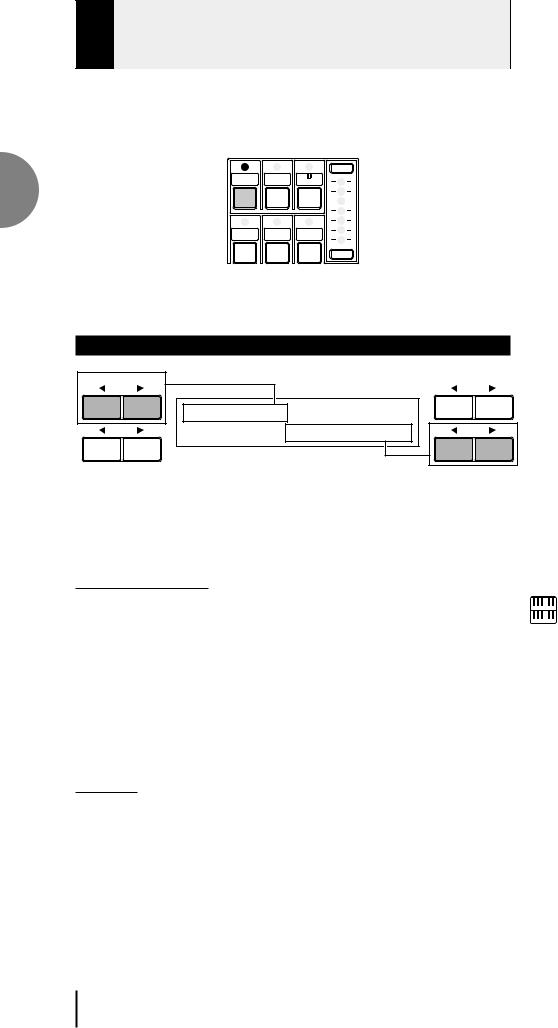
3
Effects and Controls Voice
1 Selecting from Voice Condition Pages
To call up the Voice Condition Pages:
Choose a voice on the panel, then press that voice’s panel button again. The
Voice Condition Choose a voice on page appears on the LCD display.
LEAD VOICE
VIOLIN |
FLUTE |
MAX |
OBOE |
TRUM- |
TO |
|
PET |
LOWER |
|
|
MIN |
Each voice group’s Voice Condition (except for Lead Voice) is configured with four pages. Voice Condition of the Lead Voice consists of five pages.
Voice Condition [PAGE 1] |
|
|
DATA CONTROL |
1 |
DATA CONTROL |
|
INIT.T: 8 |
Î ⁄ |
|
|
FEET:PRESET |
2
The included items are different between Pedal Voice group and the others |
Pedalboard |
|
(Only Feet setting is available with Pedal Voice group). |
|
|
|
∏1⁄ |
|
|
|
|
|
|
FEET:PRESET |
1 Initial Touch
Controls volume and timbre according to the velocity at which you strike the keys.
The harder you strike the keys, the greater the volume and the brighter the timbre will become. All voices are provided with this expressive function, making it possible to perfectly reproduce the subtle dynamic and tonal changes of actual instruments.
Higher settings make the change wider.
Range: 0 - 14
2 Feet
Determines the octave setting of the voice group. You can use a certain voice in the broader range.
PRESET is the original (factory) setting; 4' is the highest and 16' is the lowest. 2' setting is added to the Pedal Voice sections.
NOTE:
Minimum setting produces no effect at all.
30
